Search results
For "MATKA"
Matka Lake & Canyon
Matka - a piece of untouched nature
In the north-western part of Macedonia, near Skopje, the lake Matka is located on the river Treska. Lake Matka is the oldest artificial lake in Macedonia, the accumulation of which was built in 1938. The accumulation lake Matka, extends 7 km downstream along the Treska River, magnificently with its metallic gray - green color. The steep gray sedimentary dilapidated rocks, the favorite route and the eternal challenge of mountaineers - adventurers, rise high above the lake. And, with their coastlines, they sharply cut off the mysterious water surface of the lake.
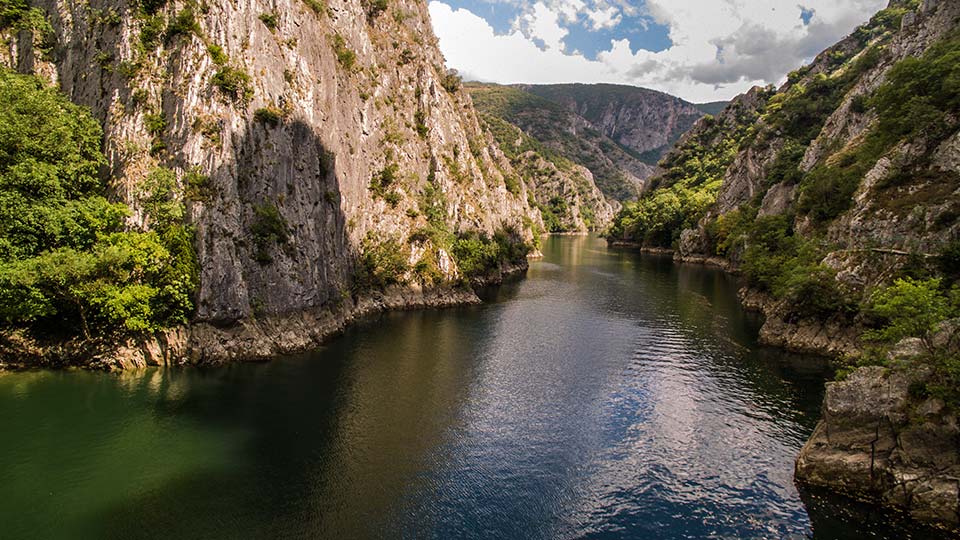
A beautiful piece of untouched nature, rich in rare animal species and endemic plants just 15km from the capital. Something that rarely any country in the world can be proud of. Matka is home to a great treasure of natural rarities, rich oak and beech forests, beautiful pink flowers of Natalie's Ramonda, white headed eagles, the unique butterflies and speleological objects. This location abounds with a number of cultural and historical monuments, mainly monasteries, due to which, rightly, they call it a small Mount Athos.
The temperature of the water in Lake Matka is 7 to 9 degrees Celsius, and the air temperature in the summer is about 9 degrees lower than that in the city. From the dam Matka 1 to Matka 2 there are nine kilometers, and to Kozjak a total of 25. It has been obtained by partitioning the river Treska with a dam ("St. Andreja"), and creating an artificial accumulation in the canyon Matka. The lake water is used for obtaining electricity, but also for irrigation of the villages in the surroundings. The lake is stocked and is often used for sports fishing. In this lake there is the underwater cave Vrelo, one of the deepest underwater caves in Europe, which has a depth of more than 203 m.
Cave Vrelo
Matka is a natural canyon, which as a geographical relief is really special, and the speleological park is one of the most fascinating in the world. From about ten caves in the speleological park, Vrelo is the only one that currently functions as a tourist attraction. Its immediate vicinity to Lake Matka makes it most suitable for tourist exploitation. And the two lakes in the interior and the few beautiful and large cave galleries make it interesting for visitors. It can be reached in twenty minutes, by one of the four boats stationed in front of the Matka Canyon restaurant. In the cave itself there are many cave decorations, among which the huge stalagmite in the form of a cone dominates, which has accumulated for 2,700 years. The sounds that are constantly heard inside the cave come from its inhabitants - the bats.
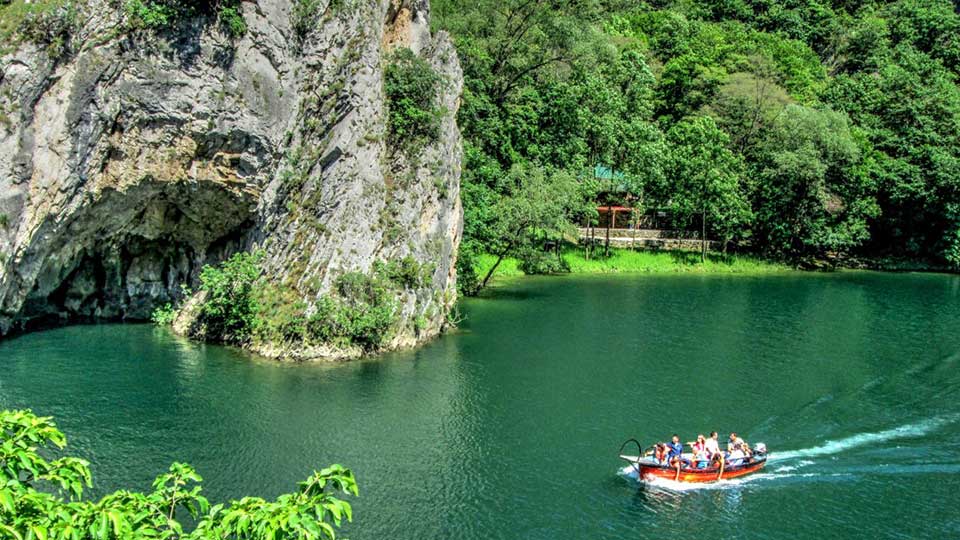
The research of the cave under Vrelo, which is filled with water, and is the only one in Macedonia of such type are still in progress, and according to the current research, it is expected that it will be the largest in Europe. Here one can see the vrelo that is assumed to come from Patishka Reka, found within a distance of 15 kilometers. Apart from the Vrelo Cave, there are also the caves Ubava and Krstalna.
Cultural-historical monuments
Besides being protected as a monument of nature, Matka also abounds with a number of cultural and historical monuments, due to which they define it as a small Mount Athos. Now there are about a dozen monasteries, among which is the shisevski monastery, dedicated to St. Nikola, built or renovated in 1345, the monastery "St. Jovan Zlatoust " in the village of Kozarevo, the monastery "Holy Mother of God" near the village of Glumovo, the monastery " St. Andreja", the churches" St. Trojca"," St. Petka","St. Atanas "," St. Nikola" in Nir and "St. Nedela". The lovers of cultural and historical monuments can receive organized arrangements, including a visit to Markov Grad, a medieval settlement-fortress from the 14th century. In the fort there are remains of the churches "St.Nedela", "St. Gjorgji" and "St. Troica".
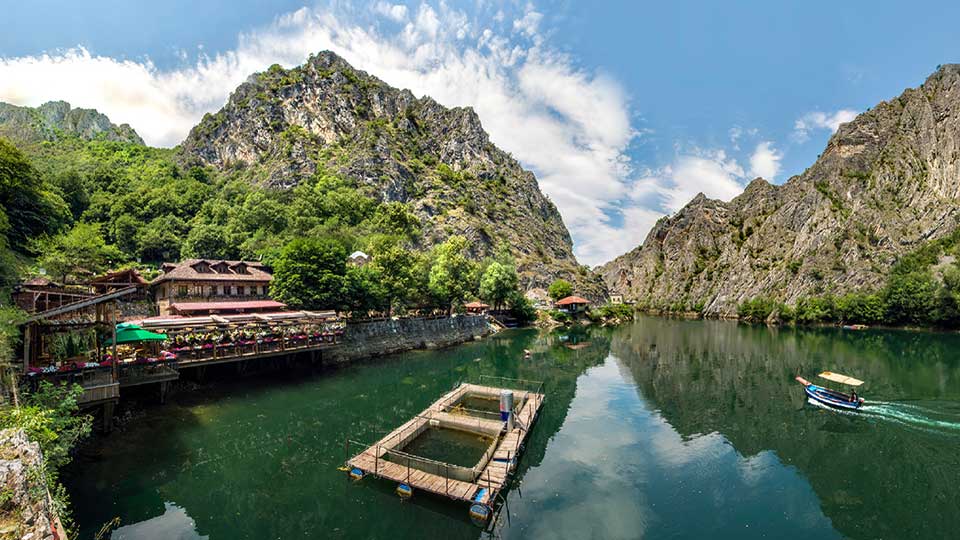
Here is the locality called Marko's Foot, which is linked to the legends of King Marko. One of them refers to the imprint in the wall of the monastery "St.Andrea", called Marko's palm. According to the legend, King Marko and his brother Andrea passed there and stopped to rest and refresh themselves. Andrea entered the meana that was located at the site of the current restaurant, in which there was a great Turkish asker. The Turks killed Andrea, and King Marko, after taking revenge, left a print from his palm in the wall of the monastery as a warning sign.
Tourist offer
The most beautiful view from the monastery "St. Nikola" extends to the mountaineering home and to the monastery "St.Andrea". You can get there on foot for about 2 hours, and after landing down, you knock using the knocker and one of the boats will come to get you. "St. Jovan Zlatoust" is the next destination, and you have half an hour's walk to the healing spring there. To Markov Grad and the church "St.Nedela", it takes about 80 minutes. The numerous trails provide extraordinary experiences and are great recreation, and the greatest pleasure is provided by the wonderful breathtaking views. Many paths intertwine and complement each other, so, they say, it is impossible to get lost.
For lovers of more extreme sports, Matka has opportunities for sport climbing and mountaineering. Given that Matka, among other things, is the heart of mountaineering in Macedonia and that is why the history of alpinism begins here. The mountaineering and sports-climbing routes are located mainly on five sites: Centrala, Otmarova Karpa, Karpa at the mountaineering home, Matkino Trlo and Iglite on Matka. Among the other contents offered is the Kayak Center where the First World Wildwater Kayak Championship was held in 1975 and the European Wildwater Kayak Championship.
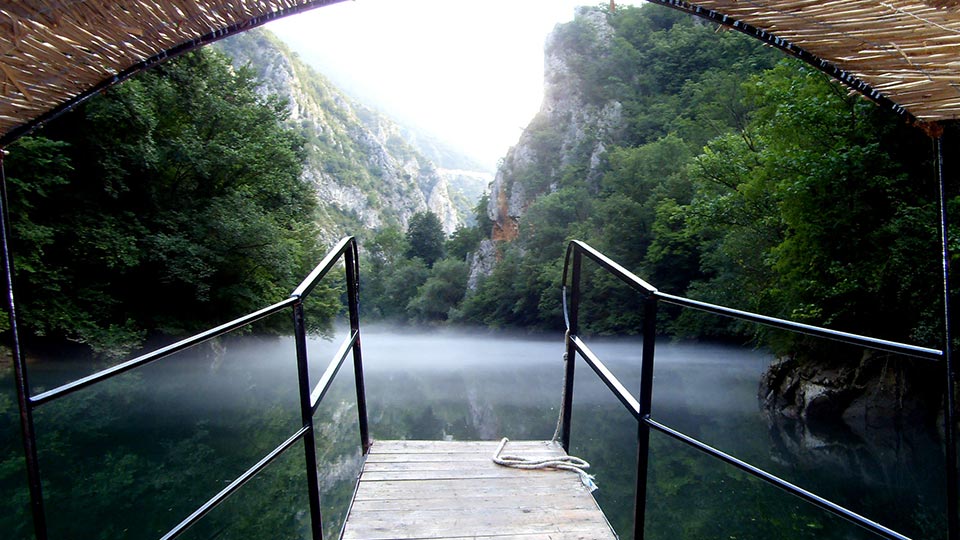
<
More information about Matka Lake can be found on this website.
mac+1 Day Tour of Skopje and the Matka Canyon, a Nature Phenomenon
1 Day Tour of Skopje and the Matka Canyon, a Nature Phenomenon
· Start of tour - We meet at the Museum of the city of Skopje. Our friendly tour guides will provide you will information regarding navigating your way around Skopje. You will then proceed with a walk along the famous ‘Macedonia Street’ towards the main city square. You will pass the Memorial House of Mother Teresa which was built in her honour as she was born in Skopje in 1910 and was awarded a Nobel Peace Prize for her humanitarian efforts.
· City Square - As you walk around the heart of Skopje – its city square, you will be treated with a guide of the monuments and buildings that paint a picture of Macedonia’s rich culture and history. You will then continue towards the Old Bazaar and pass over the greatest river in Macedonia, Vardar, via one of the most recognizable symbols of Skopje – the Stone Bridge.
· Old Bazaar - The first thing you will notice once entering the Old Bazaar is a sense of ancient times. Where, for centuries it has been buzzing with people from all over the Balkan region, trading their wares and services. You will be guided through this ancient Bazaar and experience the feeling of stepping back in time. We will have lunch at one of the local restaurants.
· The Old Town - Your experience of ancient times will only be reinforced by walking around the Old Town and hearing the stories of the Grand Fortress Kale that bears over the city. With this we finish the city tour part and head to Canyon Matka.
· Matka Canyon - Our next stop is the Matka Canyon – an outstanding work of nature of which some claim to be home to the largest underwater cave in the world. A claim that has yet to be substantiated as no one has been able to get to the bottom! Matka Canyon boasts outstanding preserved natural and geographical characteristics, in which rare endemic species have found their escape. Spot an eagle flying high in the sky, enjoy a boat ride along the magnificent gorge and explore the famous Vrelo cave full of stalagmites.
· Arrive back in Skopje
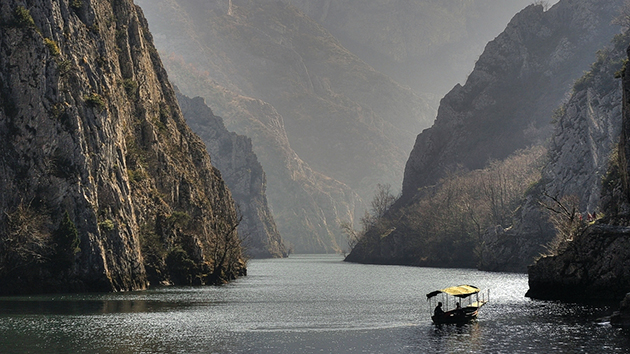
Tour organized by:
tel:+38922400513
srb+1 Day Tour of Skopje and the Matka Canyon, a Nature Phenomenon
1 Day Tour of Skopje and the Matka Canyon, a Nature Phenomenon
· Start of tour - We meet at the Museum of the city of Skopje. Our friendly tour guides will provide you will information regarding navigating your way around Skopje. You will then proceed with a walk along the famous ‘Macedonia Street’ towards the main city square. You will pass the Memorial House of Mother Teresa which was built in her honour as she was born in Skopje in 1910 and was awarded a Nobel Peace Prize for her humanitarian efforts.
· City Square - As you walk around the heart of Skopje – its city square, you will be treated with a guide of the monuments and buildings that paint a picture of Macedonia’s rich culture and history. You will then continue towards the Old Bazaar and pass over the greatest river in Macedonia, Vardar, via one of the most recognizable symbols of Skopje – the Stone Bridge.
· Old Bazaar - The first thing you will notice once entering the Old Bazaar is a sense of ancient times. Where, for centuries it has been buzzing with people from all over the Balkan region, trading their wares and services. You will be guided through this ancient Bazaar and experience the feeling of stepping back in time. We will have lunch at one of the local restaurants.
· The Old Town - Your experience of ancient times will only be reinforced by walking around the Old Town and hearing the stories of the Grand Fortress Kale that bears over the city. With this we finish the city tour part and head to Canyon Matka.
· Matka Canyon - Our next stop is the Matka Canyon – an outstanding work of nature of which some claim to be home to the largest underwater cave in the world. A claim that has yet to be substantiated as no one has been able to get to the bottom! Matka Canyon boasts outstanding preserved natural and geographical characteristics, in which rare endemic species have found their escape. Spot an eagle flying high in the sky, enjoy a boat ride along the magnificent gorge and explore the famous Vrelo cave full of stalagmites.
· Arrive back in Skopje

Tour organized by:
tel:+38922400513
ger+Matka Lake & Canyon
Lake Matka, which extends 7km down the river Treska, is marvelous with its metallic gray-green color. The steep gray sedimentary rock , favorite route and everlasting challenge for climbers - adventurers, are rising high above the lake, and its coasts, sharply cuts the mysterious water of the lake .
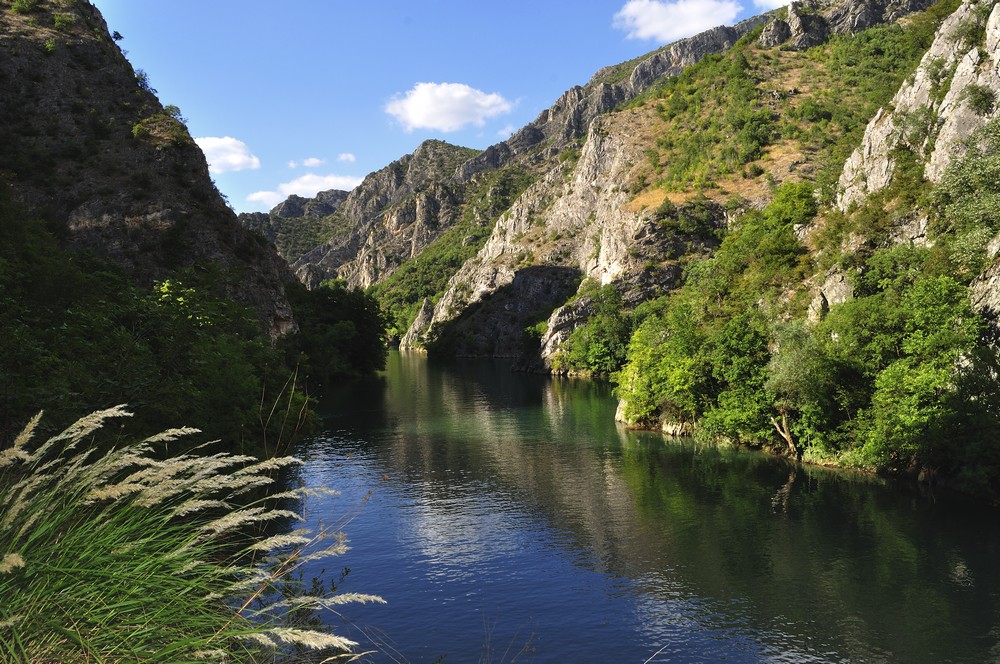
Canyon Matka is one of the most recognizable and magnificent areas in Macedonia. It is located just 15 kilometers from the capital and is a popular place for weekend recreation.
This natural canyon of the Treska River is characterized by specific shapes, different reliefs, steep slopes and vertical rocky massifs. Canyon Matka has always attracted a large number of nature lovers and researchers, because it is a natural reserve of rare animal species (such as white-headed eagles and 15 species of butterflies that live only on this site) and endemic species of plants and herbs.
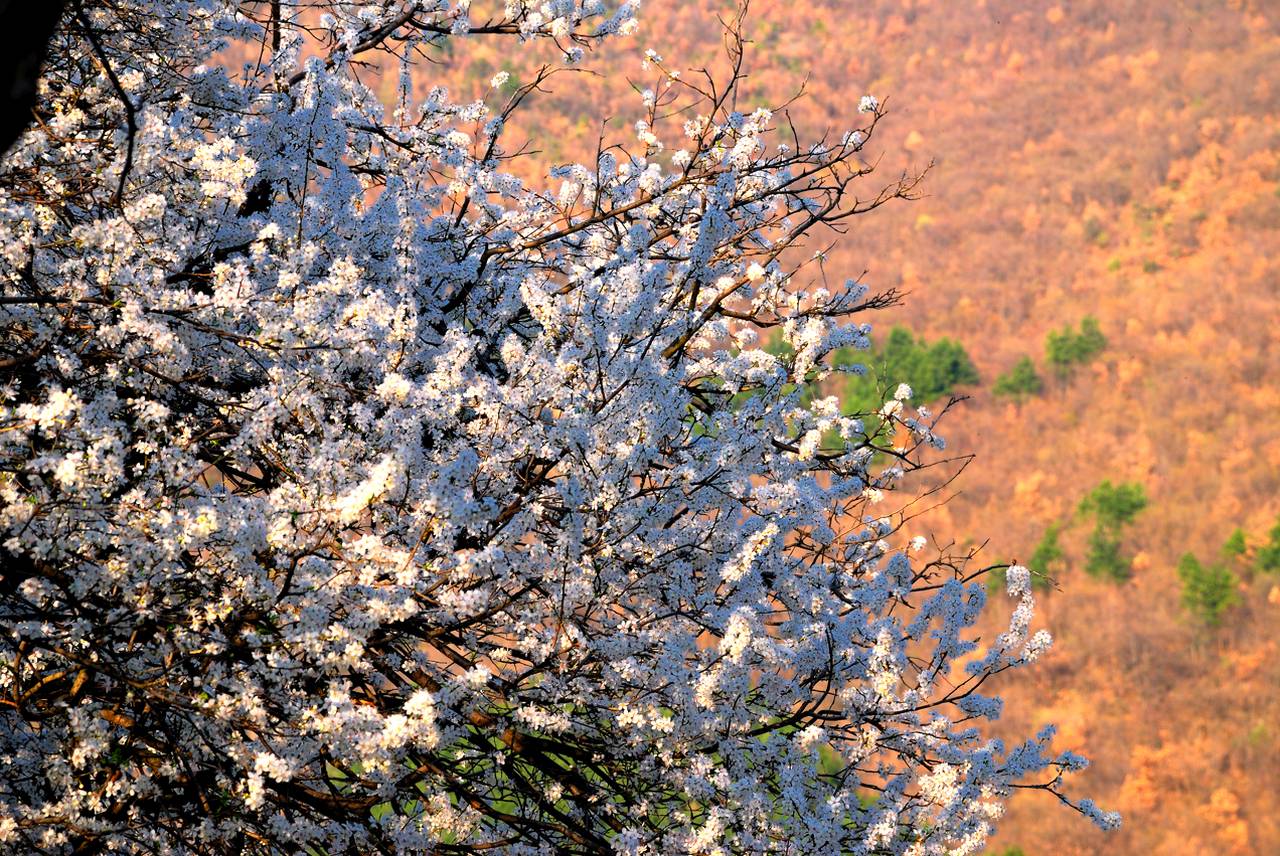
The Speleological Park is one of the most fascinating in Europe. Dozens of caves are located in this area in length from 20 to 176 meters. The most remarkable is the underground cave Vrelo that is rich in stalactites, where we can find two lakes. A huge cone-shaped stalagmite dominates, after accruing for 2700 years. At 212 meters deep, Vrelo Cave is the deepest underwater cave in the Balkans, and second deepest in Europe. The depth is still not fully discovered and remains subject to examination.
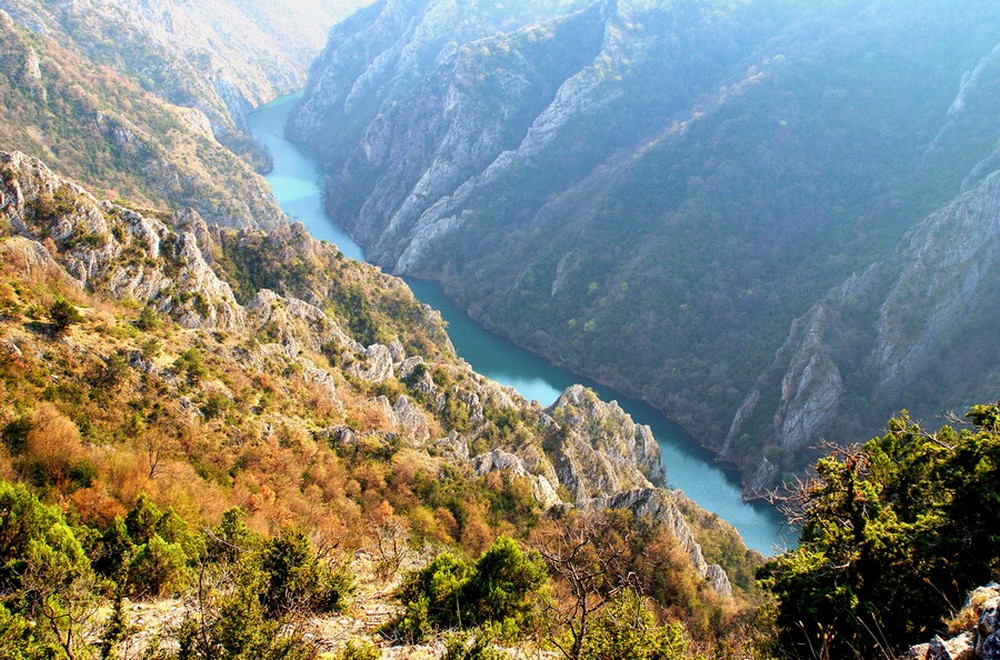
All fans of extreme sports have an opportunity to enjoy climbing and alpinism or kayaking in the wild waters. Right here on the path of Treska River, the World Cup in kayak on wild water took place in 1975. Everybody, without exception, can enjoy a tour on a small rowboat on the oldest artificial lake in Macedonia, admiring the four churches and monasteries.
In Canyon Matka a lot of paths intertwine and are connected, so it's easy to reach your desired destination. At Matka, you can only get lost in dreams, fantasies and breath.
ger+1 Day Tour of Skopje and the Matka Canyon, a Nature Phenomenon
1 Day Tour of Skopje and the Matka Canyon, a Nature Phenomenon
· Start of tour - We meet at the Museum of the city of Skopje. Our friendly tour guides will provide you will information regarding navigating your way around Skopje. You will then proceed with a walk along the famous ‘Macedonia Street’ towards the main city square. You will pass the Memorial House of Mother Teresa which was built in her honour as she was born in Skopje in 1910 and was awarded a Nobel Peace Prize for her humanitarian efforts.
· City Square - As you walk around the heart of Skopje – its city square, you will be treated with a guide of the monuments and buildings that paint a picture of Macedonia’s rich culture and history. You will then continue towards the Old Bazaar and pass over the greatest river in Macedonia, Vardar, via one of the most recognizable symbols of Skopje – the Stone Bridge.
· Old Bazaar - The first thing you will notice once entering the Old Bazaar is a sense of ancient times. Where, for centuries it has been buzzing with people from all over the Balkan region, trading their wares and services. You will be guided through this ancient Bazaar and experience the feeling of stepping back in time. We will have lunch at one of the local restaurants.
· The Old Town - Your experience of ancient times will only be reinforced by walking around the Old Town and hearing the stories of the Grand Fortress Kale that bears over the city. With this we finish the city tour part and head to Canyon Matka.
· Matka Canyon - Our next stop is the Matka Canyon – an outstanding work of nature of which some claim to be home to the largest underwater cave in the world. A claim that has yet to be substantiated as no one has been able to get to the bottom! Matka Canyon boasts outstanding preserved natural and geographical characteristics, in which rare endemic species have found their escape. Spot an eagle flying high in the sky, enjoy a boat ride along the magnificent gorge and explore the famous Vrelo cave full of stalagmites.
· Arrive back in Skopje

Tour organized by:
tel:+38922400513
Matka & Canyon
Matka est une région des plus caractéristiques et des plus belles de la Macédoine. Elle se trouve à une quinzaine de kilomètres de la capitale et représente un endroit idéal pour passer un week-end. C’est un canyon naturel de la rivière Treska, de forme caractéristique, constitué par un relief spécifique, de pentes raides et de crêtes rocheuses à la verticale.

Depuis toujours Matka attire des amoureux de la nature et des chercheurs car elle représente une réserve naturelle d’espèces animales rares (tels que les aigles à tête blanche et quinze espèces de papillons qui ne vivent que sur ce site) ainsi que des espèces endémiques et autres végétaux. Le parc spéléologique de Matka est l’un des plus fascinants d’Europe. Dans cet espace se trouve une dizaine de grottes d’une longueur allant de 20 à 176 mètres. Parmi celles-ci, la plus remarquable est celle de Vrelo qui cache dans sa cavité deux lacs ainsi que de nombreuses stalactites et stalagmites. Parmi ces dernières, la plus dominante est celle qui ressemble à une pomme de pin et dont la formation a commencé il y a 2700 ans. Avec ses 212 mètres de profondeur, à l’heure actuelle, Vrelo est la grotte sous-marine la plus profonde des Balkans, et la deuxième en Europe.

Nous n’avons toujours pas de chiffre exact en ce qui concerne sa profondeur et les recherches se poursuivent encore. Les amoureux des sports extrêmes auront la possibilité de faire de l’escalade sportive, de l’alpinisme ou du kayak en eau vive. C’est justement à cet endroit, sur le cours de la rivière Treska que se réalisa en 1975 la Coupe du Monde de kayak en eau vive. Cependant, tous, sans exception, peuvent profiter d’une promenade en bateau sur le plus ancien des lacs artificiels de Macédoine et découvrir à sa proximité les 4 églises et monastères.

A Matka se croisent un grand nombre de chemins ou sentiers, et il est donc facile d’atteindre votre destination. Vous ne pouvez vous perdre que dans les rêves et les soupirs causés par ce canyon.
fra+1 Day Tour of Skopje and the Matka Canyon, a Nature Phenomenon
1 Day Tour of Skopje and the Matka Canyon, a Nature Phenomenon
· Start of tour - We meet at the Museum of the city of Skopje. Our friendly tour guides will provide you will information regarding navigating your way around Skopje. You will then proceed with a walk along the famous ‘Macedonia Street’ towards the main city square. You will pass the Memorial House of Mother Teresa which was built in her honour as she was born in Skopje in 1910 and was awarded a Nobel Peace Prize for her humanitarian efforts.
· City Square - As you walk around the heart of Skopje – its city square, you will be treated with a guide of the monuments and buildings that paint a picture of Macedonia’s rich culture and history. You will then continue towards the Old Bazaar and pass over the greatest river in Macedonia, Vardar, via one of the most recognizable symbols of Skopje – the Stone Bridge.
· Old Bazaar - The first thing you will notice once entering the Old Bazaar is a sense of ancient times. Where, for centuries it has been buzzing with people from all over the Balkan region, trading their wares and services. You will be guided through this ancient Bazaar and experience the feeling of stepping back in time. We will have lunch at one of the local restaurants.
· The Old Town - Your experience of ancient times will only be reinforced by walking around the Old Town and hearing the stories of the Grand Fortress Kale that bears over the city. With this we finish the city tour part and head to Canyon Matka.
· Matka Canyon - Our next stop is the Matka Canyon – an outstanding work of nature of which some claim to be home to the largest underwater cave in the world. A claim that has yet to be substantiated as no one has been able to get to the bottom! Matka Canyon boasts outstanding preserved natural and geographical characteristics, in which rare endemic species have found their escape. Spot an eagle flying high in the sky, enjoy a boat ride along the magnificent gorge and explore the famous Vrelo cave full of stalagmites.
· Arrive back in Skopje

Tour organized by:
tel:+38922400513
spa+Matka Lake & Canyon
Lake Matka, which extends 7km down the river Treska, is marvelous with its metallic gray-green color. The steep gray sedimentary rock , favorite route and everlasting challenge for climbers - adventurers, are rising high above the lake, and its coasts, sharply cuts the mysterious water of the lake .

Canyon Matka is one of the most recognizable and magnificent areas in Macedonia. It is located just 15 kilometers from the capital and is a popular place for weekend recreation.
This natural canyon of the Treska River is characterized by specific shapes, different reliefs, steep slopes and vertical rocky massifs. Canyon Matka has always attracted a large number of nature lovers and researchers, because it is a natural reserve of rare animal species (such as white-headed eagles and 15 species of butterflies that live only on this site) and endemic species of plants and herbs.

The Speleological Park is one of the most fascinating in Europe. Dozens of caves are located in this area in length from 20 to 176 meters. The most remarkable is the underground cave Vrelo that is rich in stalactites, where we can find two lakes. A huge cone-shaped stalagmite dominates, after accruing for 2700 years. At 212 meters deep, Vrelo Cave is the deepest underwater cave in the Balkans, and second deepest in Europe. The depth is still not fully discovered and remains subject to examination.

All fans of extreme sports have an opportunity to enjoy climbing and alpinism or kayaking in the wild waters. Right here on the path of Treska River, the World Cup in kayak on wild water took place in 1975. Everybody, without exception, can enjoy a tour on a small rowboat on the oldest artificial lake in Macedonia, admiring the four churches and monasteries.
In Canyon Matka a lot of paths intertwine and are connected, so it's easy to reach your desired destination. At Matka, you can only get lost in dreams, fantasies and breath.
spa+1 Day Tour of Skopje and the Matka Canyon, a Nature Phenomenon
1 Day Tour of Skopje and the Matka Canyon, a Nature Phenomenon
· Start of tour - We meet at the Museum of the city of Skopje. Our friendly tour guides will provide you will information regarding navigating your way around Skopje. You will then proceed with a walk along the famous ‘Macedonia Street’ towards the main city square. You will pass the Memorial House of Mother Teresa which was built in her honour as she was born in Skopje in 1910 and was awarded a Nobel Peace Prize for her humanitarian efforts.
· City Square - As you walk around the heart of Skopje – its city square, you will be treated with a guide of the monuments and buildings that paint a picture of Macedonia’s rich culture and history. You will then continue towards the Old Bazaar and pass over the greatest river in Macedonia, Vardar, via one of the most recognizable symbols of Skopje – the Stone Bridge.
· Old Bazaar - The first thing you will notice once entering the Old Bazaar is a sense of ancient times. Where, for centuries it has been buzzing with people from all over the Balkan region, trading their wares and services. You will be guided through this ancient Bazaar and experience the feeling of stepping back in time. We will have lunch at one of the local restaurants.
· The Old Town - Your experience of ancient times will only be reinforced by walking around the Old Town and hearing the stories of the Grand Fortress Kale that bears over the city. With this we finish the city tour part and head to Canyon Matka.
· Matka Canyon - Our next stop is the Matka Canyon – an outstanding work of nature of which some claim to be home to the largest underwater cave in the world. A claim that has yet to be substantiated as no one has been able to get to the bottom! Matka Canyon boasts outstanding preserved natural and geographical characteristics, in which rare endemic species have found their escape. Spot an eagle flying high in the sky, enjoy a boat ride along the magnificent gorge and explore the famous Vrelo cave full of stalagmites.
· Arrive back in Skopje

Tour organized by:
tel:+38922400513
bug+1 Day Tour of Skopje and the Matka Canyon, a Nature Phenomenon
1 Day Tour of Skopje and the Matka Canyon, a Nature Phenomenon
· Start of tour - We meet at the Museum of the city of Skopje. Our friendly tour guides will provide you will information regarding navigating your way around Skopje. You will then proceed with a walk along the famous ‘Macedonia Street’ towards the main city square. You will pass the Memorial House of Mother Teresa which was built in her honour as she was born in Skopje in 1910 and was awarded a Nobel Peace Prize for her humanitarian efforts.
· City Square - As you walk around the heart of Skopje – its city square, you will be treated with a guide of the monuments and buildings that paint a picture of Macedonia’s rich culture and history. You will then continue towards the Old Bazaar and pass over the greatest river in Macedonia, Vardar, via one of the most recognizable symbols of Skopje – the Stone Bridge.
· Old Bazaar - The first thing you will notice once entering the Old Bazaar is a sense of ancient times. Where, for centuries it has been buzzing with people from all over the Balkan region, trading their wares and services. You will be guided through this ancient Bazaar and experience the feeling of stepping back in time. We will have lunch at one of the local restaurants.
· The Old Town - Your experience of ancient times will only be reinforced by walking around the Old Town and hearing the stories of the Grand Fortress Kale that bears over the city. With this we finish the city tour part and head to Canyon Matka.
· Matka Canyon - Our next stop is the Matka Canyon – an outstanding work of nature of which some claim to be home to the largest underwater cave in the world. A claim that has yet to be substantiated as no one has been able to get to the bottom! Matka Canyon boasts outstanding preserved natural and geographical characteristics, in which rare endemic species have found their escape. Spot an eagle flying high in the sky, enjoy a boat ride along the magnificent gorge and explore the famous Vrelo cave full of stalagmites.
· Arrive back in Skopje

Tour organized by:
tel:+38922400513
Matka Kanyonu
Matka Kanyonu


Bu alanda 20 ile 176 metre uzunluğunda onlarca mağara bulunmaktadır. Bunlardan en çok göze çarpan Vrelo yeraltı mağarasıdır, içinde iki göl bulundurmakta, ayrıca sarkıtlarla çok zengindir. Mağarada 2700 yıldır oluşan koni şeklindeki dikit domine etmektedir. 212 metre derinliği ile Vrelo şu anda Balkanlar’da en derin sualtı mağarasını oluşturmaktadır. Avrupa’da ise ikinci. Derinliği hala tam olarak keşfedilmiş değil, araştırmalar hala devam ediyor.

Ekstrem doğa sporları hayranları, tırmanma ve dağcılık veya azgın sularda kayak keyfi ni çıkarma fırsatını yakalayabilirler. Tam burada, 1975 yılında, Treska Nehri’nde azgın sularda Dünya Kupası kayağı düzenlenmiştir. Her- kes, istisnasız, Makedonya’nın en eski yapay gölünde tekne ile dolaşabilme imkanına sahip. Kanyonun yakınlığında 4 kilise ve manastır bulunmaktadır. Matka Kanyon’unda çok sayıda yol kesişmekte ve bağlanmaktadır, bu yüzden istediğiniz hedefe ulaşmak çok daha kolaydır. Sadece, Matka Kanyonu’nun sunduğu hayal ve rüyalarda kaybolabilirsiniz.
alb+1 Day Tour of Skopje and the Matka Canyon, a Nature Phenomenon
1 Day Tour of Skopje and the Matka Canyon, a Nature Phenomenon
· Start of tour - We meet at the Museum of the city of Skopje. Our friendly tour guides will provide you will information regarding navigating your way around Skopje. You will then proceed with a walk along the famous ‘Macedonia Street’ towards the main city square. You will pass the Memorial House of Mother Teresa which was built in her honour as she was born in Skopje in 1910 and was awarded a Nobel Peace Prize for her humanitarian efforts.
· City Square - As you walk around the heart of Skopje – its city square, you will be treated with a guide of the monuments and buildings that paint a picture of Macedonia’s rich culture and history. You will then continue towards the Old Bazaar and pass over the greatest river in Macedonia, Vardar, via one of the most recognizable symbols of Skopje – the Stone Bridge.
· Old Bazaar - The first thing you will notice once entering the Old Bazaar is a sense of ancient times. Where, for centuries it has been buzzing with people from all over the Balkan region, trading their wares and services. You will be guided through this ancient Bazaar and experience the feeling of stepping back in time. We will have lunch at one of the local restaurants.
· The Old Town - Your experience of ancient times will only be reinforced by walking around the Old Town and hearing the stories of the Grand Fortress Kale that bears over the city. With this we finish the city tour part and head to Canyon Matka.
· Matka Canyon - Our next stop is the Matka Canyon – an outstanding work of nature of which some claim to be home to the largest underwater cave in the world. A claim that has yet to be substantiated as no one has been able to get to the bottom! Matka Canyon boasts outstanding preserved natural and geographical characteristics, in which rare endemic species have found their escape. Spot an eagle flying high in the sky, enjoy a boat ride along the magnificent gorge and explore the famous Vrelo cave full of stalagmites.
· Arrive back in Skopje

Tour organized by:
tel:+38922400513
alb+1 day tour from mount Vodno to the Matka canyon
Hiking from the city Skopje across the ridge of mount Vodno to the canyon Matka.
Interesting hiking fulfilled with moving through nature and a view on Skopje city, which gives the tour a combined urban-outdoor feeling.
Tour organized by:
email: [email protected]
tel: +389 70 319 301
Skopje
SKOPJE
Metropoli: tra il patrimonio storico e vita urbana
Skopje è una città della parte centrale della Penisola Balcanica. E’ ben collegata con la zona mediterranea al sud e la regione dell’Europa centrale e settentrionale. Attraverso la Gola di Kachanik si collega con il Mare Adriatico. Verso l’est, attraverso Kumanovo e Kriva Palanka si collega con la Bulgheria, verso l’ovest con Polog, Vallata di Kichevo, la regione di Ohrid e Prespa e Repubblica di Albania.
Skopje risale al periodo paleoantico. Questa città aveva un’importanza strategica nel periodo antico nota sotto il nome di Skupi.
Gli scavi della città antica Skupi si trovano nella zona di Zajchev Rid sopra la confluenza del fiume Lepenenec nel Vardar, vicino al villaggio odierno Zlokukjani. Skupi era il capoluogo della regione Dardania.
Nell’epoca dell’Ottaviano Augusto, tra il 13 e 11 anno a.C Skupi diventò un accampamento legionario. Più tardi, Skupi si sviluppò in una delle più grandi città romana e uno dei più importanti insediamenti alla strada da Salonicco verso Dunav. La città aveva una forma rettangolare con una superficie di 40 Ha e muro con spessore di 3,2 metri e ottenne uno status di colonia. La città fu distrutta da un terremoto nel 518.
Nel luogo dell’antica Skupi sono trovate delle tracce materiali e tra gli scavi di maggiore importanza sono le parti del teatro scavate nel 1936. Nel posto presente la città erege dopo il 518.
Nella seconda metà del VI secolo, le fondamenta della nuova Skopje probabilmente vennero messe dall’imperatore Giustiniano I (527-565). Nel suo onore anche l’insediamento venne battezzata Justiniana Prima. Si suppone che nel periodo del suo governamento venisse costruita la fortificazione Kale, la quale si trova alla riva sinistra del fiume Vardar. Nei seguenti due-tre secoli, con l’arrivo dei Kumani e gli Slavi, la città era meta di saccheggio e devastazione che portò a uno sviluppo lento della città. Dopo il IX secolo Skopje divenne una sede bizantina molto importante. Verso la fine del X secolo, durante l’Impero di Samoil, Skopje viene menzionata come una sede arcivescovile. Nel XII il geografo arabo Idrizi la menziona come una città ricca sotto il nome di Iskubia.
La città ebbe uno sviluppo maggiore nel tempo in cui governava l’imperatore Dushan. In quel tempo a Skopje, una sede amministrativa e culturale, si svolgeva un commercio favorito dai commercianti di Ragusa (Dubrovnik). Allora fu emanato anche Il Codice di Dushan.
Durante l’Impero Ottomano Skopje continuò il suo progresso. Arrivarono immigranti dall’ Asia Minore. Nella città vennero costruite tante moschee, bagni turchi (hamam) e alberghi (An). Nel vecchio mercato di Skopje fu costruito Kurshumli An . Daut-Pashin Amam è una terma fondata dal grande visir di Rumelija. Il Ponte di pietra sul fiume Vardar fu costruito verso la fine del XV secolo. Il ponte collega la vecchia e la nuova parte della città. L’acquadotto per Skopje fu costruito verso la fine del XV secolo. Si trova alla parte destra della vecchia strada Skopje-Kachanik. Alcune riparazioni e una ristrutturazione migliore furono eseguite all’inizio del XIX secolo. La chiesa San Spas fu innalzata verso la fine del XVII secolo.
Nel XVII secolo la città ebbe un progresso economico, culturale e territoriale con ben sviluppato artigianato, commercio e lavorazione del cuoio. Ma, a causa della peste, e con l’ordine del generale austriaco Piccolomini, nel 1689 Skopje fu incendiata e completamente distrutta. Tanto tempo dopo, la città non pote’ essere risollevata e riportata ai tempi di prima.
La città riprese il progresso nel XIX secolo, soprattutto dopo la costruzione della Ferrovia di Vardar nel 1973, e ancora di più nel 1888, quando si incrociarono la Ferrovia di Moravia e di Vardar. La città aveva un influsso continuo di popolazione. Nel 1836 aveva 10.000 abitanti, nel 1858-20.000 abitanti, alla fine del XIX secolo il numero degli abitanti crebbe a 32.000 abitanti e prima delle guerre balcaniche a 47.000 abitanti.
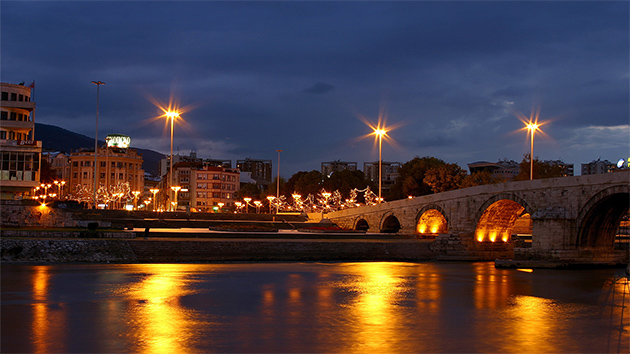
Con i nuovi confini verso la Grecia nel 1912, quando tutto il territorio gravitava attorno a Salonicco, si voltò verso Skopje, così che tra le due guerre mondiali Skopje ebbe un progresso economico e territoriale. Nel periodo dopo la Prima guerra mondiale, cioè nel 1931, Skopje aveva 65.870 abitanti. Dopo la Seconda guerra mondiale, Skopje divenne il maggiore e il più moderno insediamento nel paese sia dal punto di vista urbano, economico e di popolazione.
Dopo il 1948 la popolazione di Skopje cresce continuamente. Specialmente si nota la crescita dopo il 1953, contemporaneamente al progresso funzionale della città. Tranne la natalità, il numero degli abitanti crebbe anche per via meccanica: 1948-88.209 abitanti, 1953 -119.134 abitanti, 1961 -165.529 abitanti, 1971- 312.980 abitanti, 1994-444.299 abitanti, 2002 -467.257 abitanti.
Come il maggiore agglomerato di popolazione, Skopje ha un vasto territorio di gravitazione che supera i confini della Repubblica di Macedonia. Con la crescita della popolazione, cresce anche il territorio di Skopje. Oggidì attorno a Skopje sono costruiti tanti insediamenti dei dintorni.
KALE
La fortezza di Giustiniano Primo
Si considera che la fortezza, conosciuta anche come Kale di Skopje, fosse popolata sin dal periodo Neolitico e la prima Età del bronzo. Ci sono numerosi dati archeologici che ne sono la testemonianza. La fortezza stessa risale all’epoca dell’imperatore Giustiniano I (535). Per la posizione strategica e il ruolo, la fortezza veniva attaccata e usata da diversi conquistatori. Dopo la caduta dell’Imprero di Samoil (1018), la città fu invasa da Petar Deljan (1014-1041). Dopo, venne invasa anche dai Kumani, Skiti, Pechenezi ed altri. Nella fortezza sono trovati diversi resti archeologici. Oggidì Kale, la fortezza di Skopje è uno dei monumenti più rimarchevoli di Skopje con presenza di diversi motivi culturali e turistici.
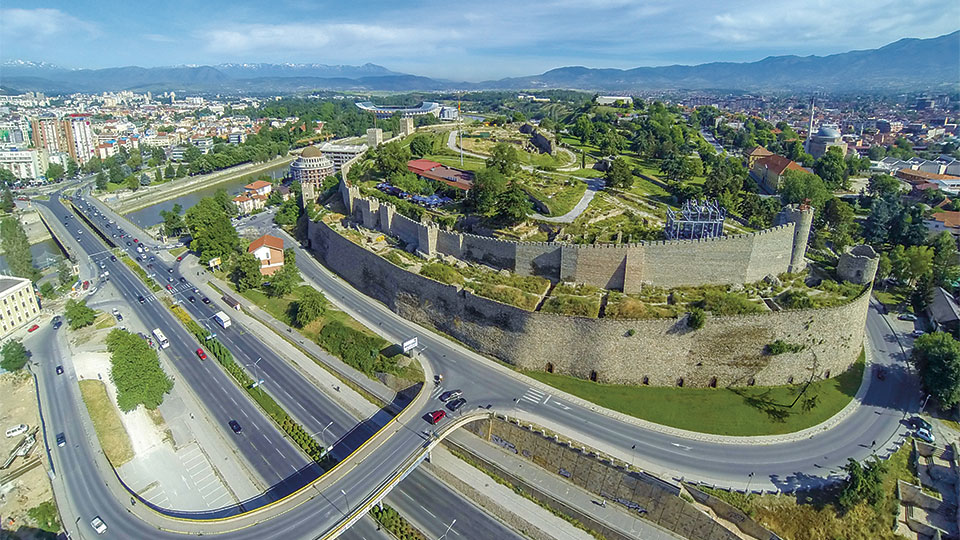
IL PONTE DI PIETRA
Il simbolo della Skopje del XV secolo
Il Ponte di Pietra sul fiume Vardar fu costruito nella prima metà del XV secolo. Il ponte collega la città vecchia e la nuova. Nel 1905 furono costruiti i percorsi lungo fiume e nell’ultimo decennio del XX secolo fu completamente ristrutturato. Alla riva sinistra del fiume sul ponte si trova una piastra memoriale sugli abitanti di Skopje fucilati nel 1944 durante l’occupazione fascista.
Nella sua forma originaria, il ponte aveva 13 volte con lunghezza totale di 215 metri e larghezza di sei metri. Con lo scopo di ritornare all’apparenza originaria del Ponte di Pietra, nel 1992 sono stati iniziati nuovi interventi con cui il ponte ha ottenuto la sua larghezza di prima.
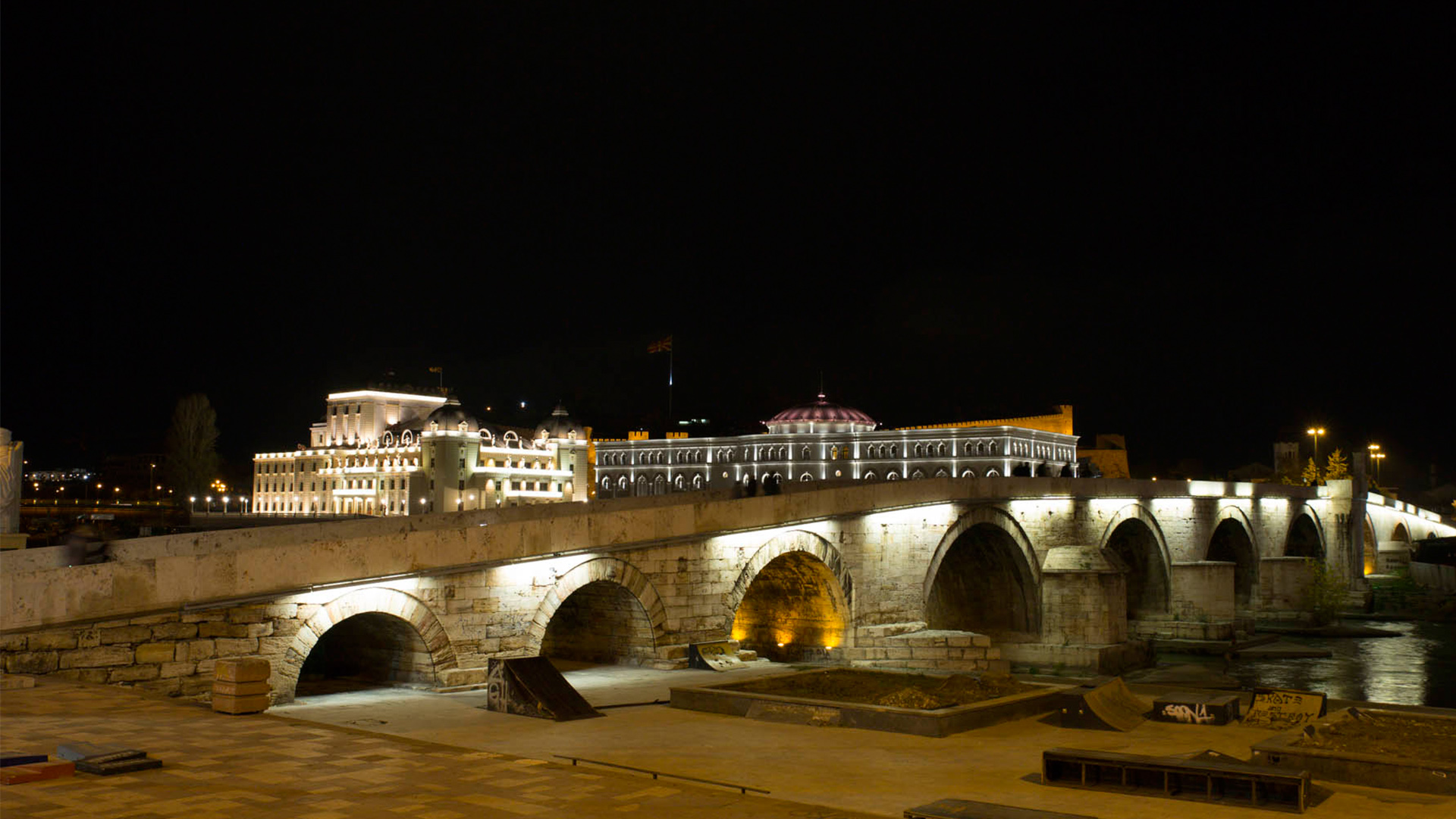
PORTA MACEDONIA
Simbolo della grande vittoria storica – la fondazione della Repubblica di Macedonia, stato indipendente e sovrano
Costruita nel 2011 e messa in funzione al Natale del 2012. La struttura ha dimensioni di 20X10 metri ed altezza di 21 metri. La facciata è decorata con 32 rilievi di intaglio profondo con superficie di 193 m2.
Vengono presentate scene del periodo preistorico iniziando dalla palafitte nella Baia degli Ossi, nonche’ le scene dell’antichità con Filip II e Alessandro III di Macedonia, del periodo romano con Giustiniano I, del Medioevo con Zar Samuil, Krale Marko e Karpos, fino al XX secolo con Ilinden, Asnom, l’esodo della Macedonia Egea e l’8 settembre del 1991- la proclamazione della Macedonia indipendente.
Sulla facciata si trovano scene del monastero San Jovan Bigorski, è presentata anche una casa autentica di Ohrid, Il Daut Pashin- Hamam, il Ponte della poesia a Struga. Nel suo interno si trova anche un negozio di souvenir e galleria a due livelli, includendo anche più in alto una piattaforma panoramica.
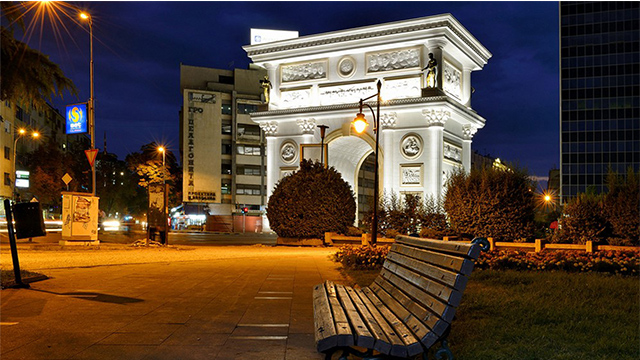
LA PIAZZA MACEDONIA
La connessione principale delle unità della città della riva sinistra e destra di Vardar
La piazza Macedonia di Skopje più precisamente venne costruita nel periodo tra le due guerre mondiali, ovvero tra il 1920 e il 1940. Si trova accanto al Ponte di Pietra, come una connessione principale delle unità tra la riva sinistra e destra del fiume Vadar. Attorno alla piazza furono situate delle strutture importanti: La Banca Nazionale, L’Ufficio Postale, la Casa degli Ufficiali, il Centro commerciale Na-Ma, l’albergo Macedonia, Palazzo Ristikjev. Ma, dopo la Seconda guerra mondiale e soprattutto dopo il disastroso terremoto del 1963, alcune delle strutture crollarono e per questo l’aspetto odierno della piazza è un po’ diverso. Nonostante ciò accanto alla piazza o molto vicino si trovano importanti strutture amministrative, culturali, commerciali, bancarie, turistiche e di ristorazione. Nella sua vicinanza è anche la Piazza Pela con la Porta Macedonia, con la funzione di una vera porta attraverso la quale si entra nella piazza.
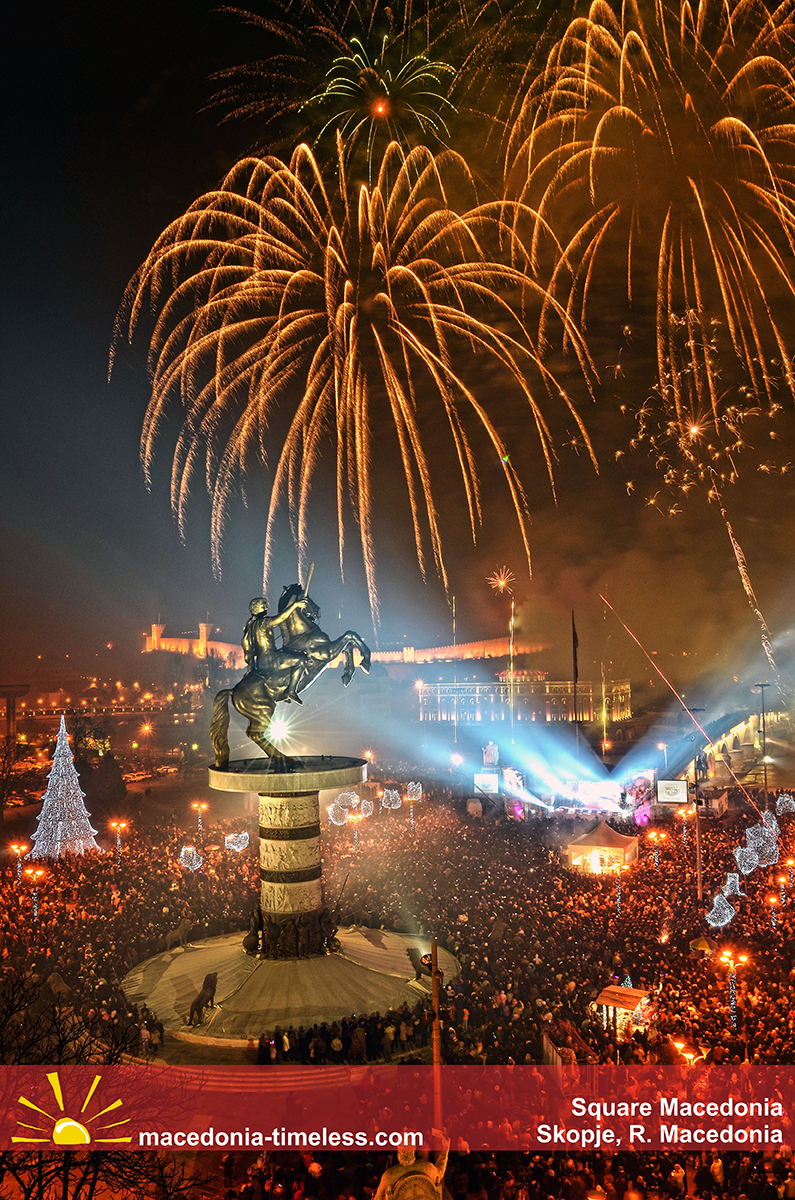
GUERRIERO A CAVALLO
Un monumento ad Alessandro III di Macedonia
Collocato in una posizione centrale della piazza Macedonia, il monumento è stato ufficialmente promosso l’8 settembre del 2011, in occasione del 20° anniversario della proclamazione dell’indipendenza della Repubblica di Macedonia.
Il monumento rappresenta una composizione fatta da più elementi. Il monumento in bronzo ad Alessandro ha altezza di 14,5 metri e pesa 30 tonnellate. Nella parte centrale della colonna di dieci metri è collocato il guerriero Alessandro II di Macedonia, conosciuto anche come Alessandro Magno, rivolto verso la parte dove sorge il sole. In questo basamento ci sono tre anelli con delle piastre, in cui raffigurano tre battaglie. Tra loro ci sono anche tre anelli in bronzo, con decori e rilievi decorativi. Attorno alla colonna si trova la fontana completata con otto soldati di bronzo alti 3 metri e otto leoni alti due e mezzo metri, di cui quattro sono rivolti verso la fontana. Il monumento è un’opera di Valentina Karanfilova-Stefanova.
Monumenti collocati nella zona centrale della città (Spomenici vo centralnoto gradsko podracje)
Nel periodo compreso da il 2010 e 2012 la Piazza Macedonia è stata arricchita da alcuni monumenti dedicati a noti rivoluzionari del periodo di Ilinden 1903 e ASNOM 1944. Proprio accanto al Ponte di Pietra, ergono orgogliosamente le statue dei rivoluzionari macedoni Goce Delchev e Dame Gruev. Di fronte a loro in una pietra di marmo è scolpita la statua del primo presidente del Presidio dell’Assemblea popolare della Repubblica Popolare di Macedonia, Metodija Andonov-Chento, alto cinque metri e pesante 25 tonnellate. Di fronte alla statua di Chento, proprio accanto il grandioso Guerriero a cavallo, erge una statua di cinque metri dello Zar Samoil, collocata ad un basamenti con altezza di 3,5 metri. Sulla piazza stessa si trova anche la statua di Dimitrija Chupovski, e nel Parco della Donna Combattente di fronte al Parlamento della Repubblica di Macedonia, è collocato il monumento dedicato alla prima sessione plenaria dell’ASNOM (movimento anti-fascista per la liberazione della Macedonia).
Alla sponda del fiume Vardar, vicino al Ponte di Pietra, dalla parte della piazza si trova la statua bianca di Giustiniano, alto cinque metri, collocato ad un basamento di 3,5 metri. Di fronte ad esso sono collocate le statue dei Barcaioli di Salonicco fatte in bronzo. Vicino al Ponte di Pietra, dalla parte della Charshija (Old Bazar) sono collocate le statue del ribelle Petar Karposh e Gjorgjija Pulevski, nonche’ quelle di SS. Cirillo e Metodio e s.Clemente e s. Naum di Ohrid.
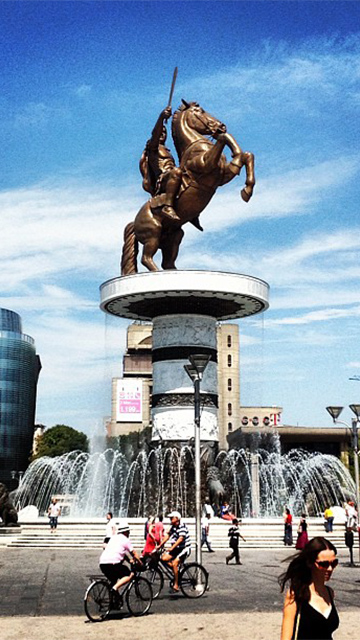
La casa memoriale di Madre Teresa
Costruita accanto al posto della sua casa di nascita
La casa memoriale e la statua di Madre Teresa (1910-1997) sono collocate in via Macedonia, nel centro della città di Skopje. Sono dedicate alla grande missionaria in campo umanitario Anjeza Gonxha Bojaxhiu- Madre Teresa, nata a Skopje, vincitrice del premio Nobel per la pace nel 1979. Oggi le Missionarie della carità superano 3.000 suore e 500 frati sparsi in diversi paesi del mondo.
Madre Teresa è stata nominata cittadina onoraria della sua città natale Skopje, che dopo essere apartita a svolgere attività missionarie per aiutare gli affamati e poveri ha visitato quattro volte: nel 1970, 1978, 1980 e 1986.
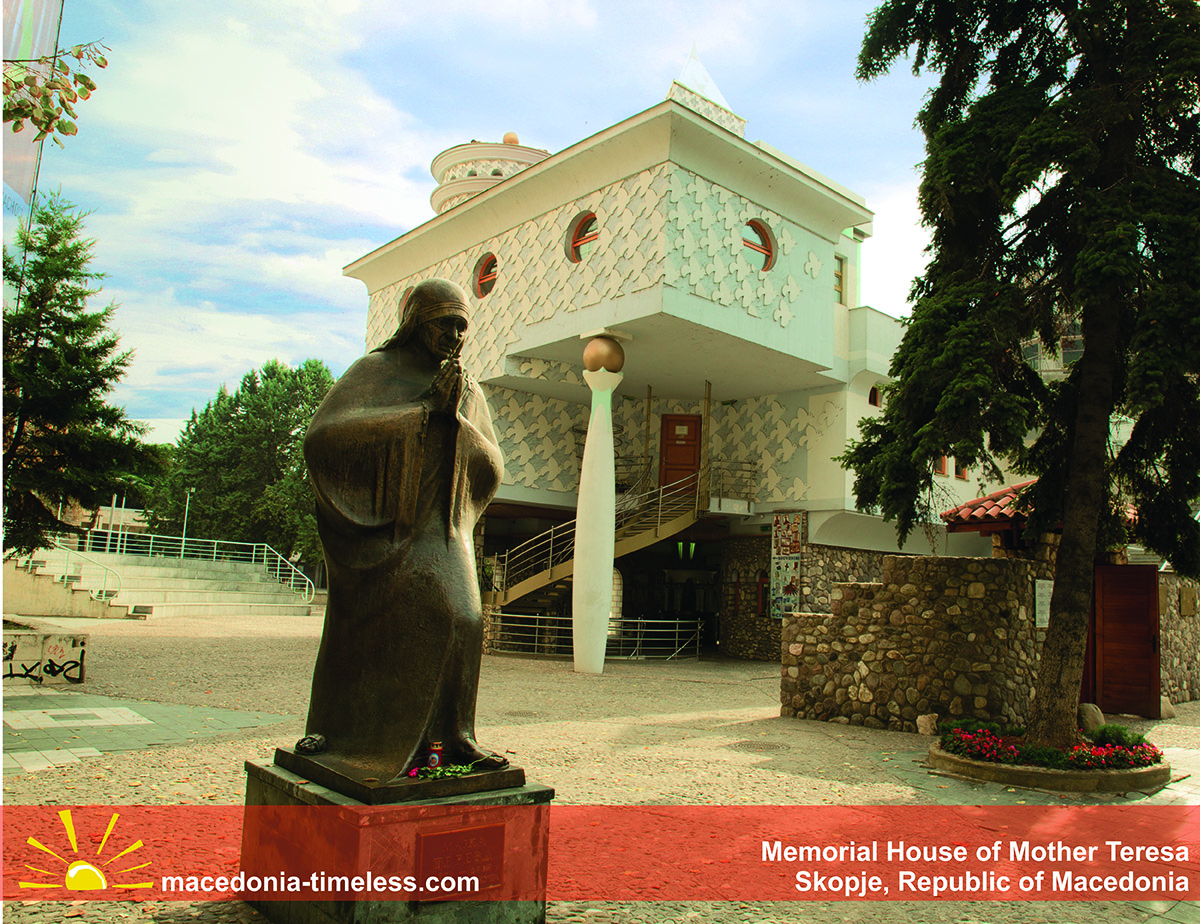
La chiesa Cattedrale S. Clemente di Ohrid
Uno dei segni principali della Skopje odierna e una delle chiese più riconoscibili nella Macedonia
La cattedrale s. Clemente di Ohrid è una struttura dalla storia recente dell’edilizia macedone. La sua costruzione si è svolta negli anni settanta e ottanta del XX secolo. E’ stata consacrata nel 1990. E’ sede della Chiesa macedone ortodossa- Arcivescovato di Ohrid. E’ collocata nel centro di Skopje.
Vecchio Bazar (Old Bazaar)
Se non ci si sente lo spirito del Vecchio Bazar e come se non ci si fosse mai stati a Skopje
A Skopje, alla parte sinistra del Vardar, attraverso il Ponte di Pietra si trova il Vecchio Bazar di Skopje. Rappresenta una parte della città con una ricca e svariata storia, tradizione, cultura e archittetura.
Nello spirito delle occasioni storiche e fasi di sviluppo, la cultura dell’organizzazione e la tradizione del vivere nel Vecchio Bazar, sono conservate varie strutture funzionali dal periodo ottomano, e ne sono costruite anche nuove che rappresentano l’epoca moderna. Si tratta di Bezisten di Skopje, Kapan An, Suli An, Kurshumli An, Daut Pashin Hamam, Chifte Hamam, la chiesa S. Spas, la chiesa S. Dimitrij, il complesso dei musei della Macedonia (storico, archeologico, etnologico).
Il Vecchio Bazar che risale al XII secolo e il cui sviluppo fiorva dal XV al XIX secolo, rappresenta un insieme complesso economico-commerciale, architettonico, culturale e tradizionale. E’ costruito in uno stile orientale, con alcune vie più larghe, ma la maggior parte sono strette e selciate. Alle vie, ci sono botteghe artigianali, sistemate una accanto all’altra. Sono presenti diversi artigianati tradizionali, fabbri, orefici, vasai, calzolai, sarti, orologiai, stagnini, ramai, sellai con tante diverse attività di produzioni e servizi. Ci sono anche diversi negozi con merce industriale moderna e prodotti che si possono trovare solo qui. Il Vecchio Bazar ha anche il maggiore mercato verde di Skopje. Il Bazar è anche centro delle osterie tradizionali che offrono diversi piatti tradizionali.
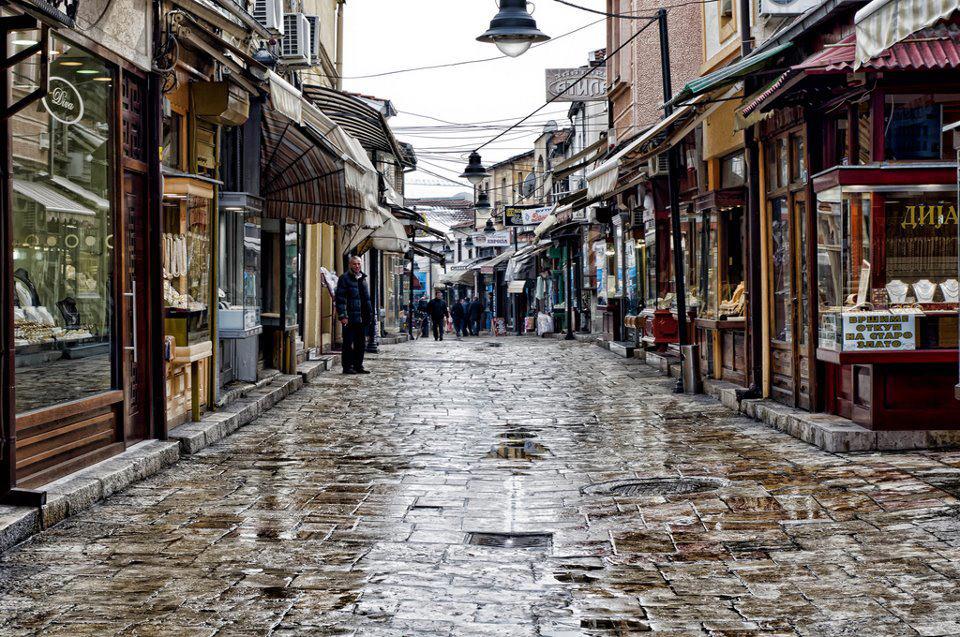
Daut- Pashin Hamam (XV)
Monumento impressionante della architettura islamica e una galleria d’arte
Daut- Pashin Hamam è un bagno eretto durante il XV secolo del grande visir di Rumelija. Probabilmente fu costruito dai muratori della conosciuta scuola dei muratori di Debar. Costruito nel centro di Skopje, a cento metri del Ponte di Pietra, l’hamam è ristrutturato nel 1948. La parte più particolare è il tetto, composto di 13 cupole posizionate disugualmente. Nella parte interna ci sono 15 camere, di diversa grandezza, collegate tra di esse con passaggi con le volte decorate in ornamenti orientali. Oltre a Chifte Hamam e Mala Stanica, oggi fa parte della Galleria nazionale della Macedonia. Daut-Pashin Hamam dispone di una collezione del XV e XVI secolo, di una ricca collezione di dipinti del XVIII e XIX secolo, nonche’ della pittura macedone contemporanea.
Kurshumli An (XVI)
Il maggiore dei caravanserragli dell’epoca- patrimonio culturale riconoscibile di Skopje
Si suppone che l’imponente Kurshumli An (caravanserraglio di piombo) fosse costruito nella metà del XVI secolo. Consisteva di due parti: la prima per l’alloggio dei mercanti e la merce e l’altra era lo stallaggio, camere accessorie e camere dei servitori. Per un lungo periodo serviva da punto di sosta dei mercanti e le carovane e aveva un ruolo importante per lo sviluppo della vita mercantile nelle città. Conservò Il ruolo di luogo di pernottamento fino alla fine del XIX secolo e poi fu trasformato in prigione. Probabilmente ottenne il nome durante il XIX, per il tetto che fu costruito di piombo. La parte interna di Kurshumli An è eccezionale. Prevale una tranquillità straordinaria e per il modo di costruzione crea un effetto di eco. Fanno impressione i muri semi circolari del secondo piano e il shardivan nel mezzo della struttura. Oggi nell’An si trova il lapidario del Museo archeologico, collocato nelle celle del pianterreno. Ogni cella contiene monumenti risalenti allo stesso periodo e zono, a partire dal I secolo a.C fino al tardo antico (IV secolo), quando Macedonia era provincia romana. La collezione consiste di 130 monumenti.
Suli An (XV secolo)
Ospizio della città il quale oggi rappresenta una galleria e museo
Suli An è una struttura risalente al XV secolo, costruita da Ishak Bey. Nel XVI secolo fu ristrutturato in modo che i piani superiori rappresentassero delle botteghe commerciali. Durante il terremoto era gravemente danneggiato, ma è stato ricostruito con il suo aspetto originario. Oggi è sede della Galleria dell’arte contemporanea e la Facoltà delle belle arti, e dal 1983 ci si trova il Museo del Vecchio Bazar di Skopje.
Moschea di Mustafa Pasha
Una delle più belle e più opulenti edifici dal perido ottomano a Skopje
La moschea di Mustafa-Pasha fu costruiita dal comandante Mustafa pasha nel 1492. Si trova di fronte all’entrata della fortezza Kale di Skopje. La moschea rappresenta una piattaforma rettangolare architettonica costruita dai blocchi di marmo decorato con diversi ornamenti. Il minareto è costruito in blocchi travertini. In questa moschea si trova il ben decorato sarcofago di Uma, la figlia del fondatore della moschea, poi shardivan, resti degli imareti, le scuole scondarie muslmane ecc. Oggi rappresenta un importante monumento di cultura e luogo di preghiera spirituale dei religiosi musulmani.
La Torre dell’orologio
La prima Torre dell’orologio nell’Impero Ottomano
La Torre dell’orologio nel Vecchio Bazar risale al periodo del XVI secolo, cioè al periodo tra il 1566 e il 1572. Viene considerata la prima Torre nell’Impero Ottomano, come parte della moschea del Sultan Murat. E’ alta 40 mestri e consiste di alcune parti che finiscono con una cupola. L’orologio è perso durante il terremoto a Skopje nel 1963, quando la Torre era gravemente dannesggiata. Oggi attira grade attenzione con la sua rimarchevolezza.
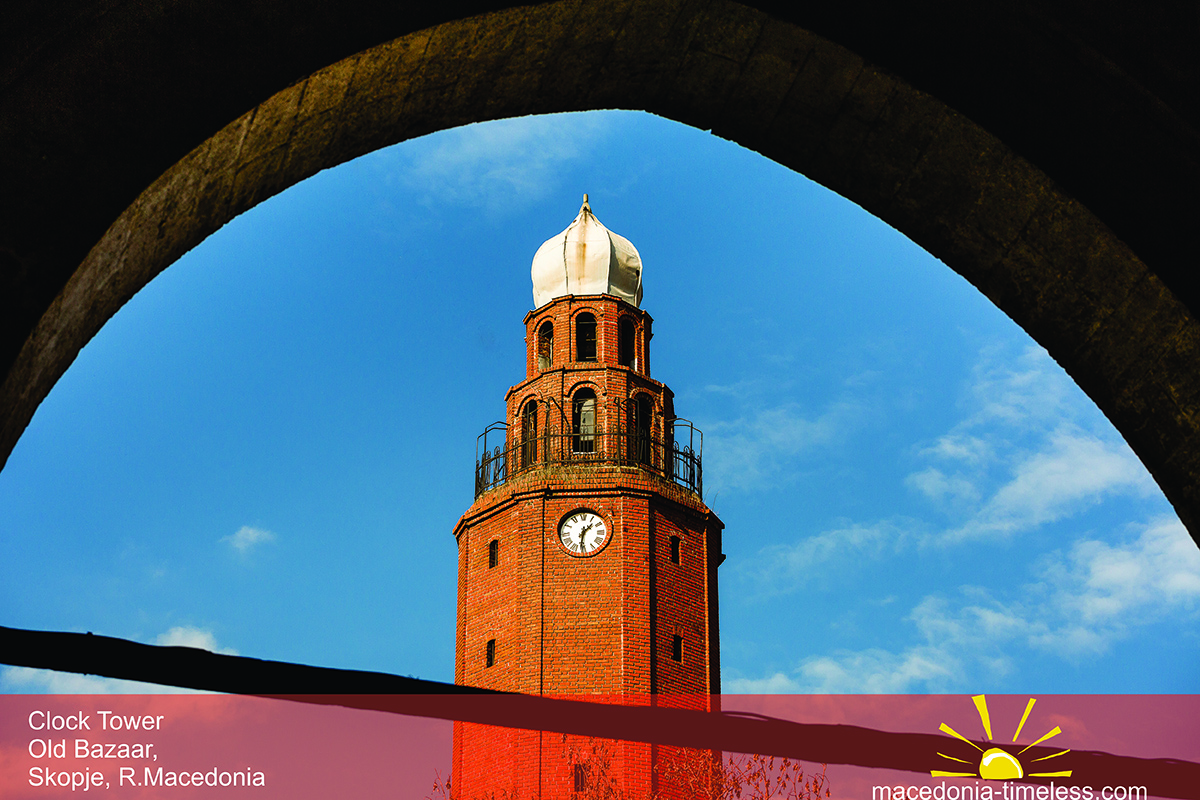
La statua di Skender-Bey
Eroe che lottava per i valori universali
Gjergj Kastriot- Skender Bey (1405-1468) è un eroe nazionale di Albania, combattente per la libertà dalla invasione ottomana. E’ un’opera di Toma Tomai Dema Bekir di Albania, il monumento dedicato a Skender-Bey è stato esposto nel 2006. Skender –Bey viene considerato un grande leader che combatteva e promuoveva i valori europei contro le invasioni ottomane nei Balcani. Il monumento rappresenta una conferma dello spirito di co-esistenza nella città di Skopje.
La chiesa S. Spas (Santissimo Salvatore) (XVII secolo)
L’iconostasi nella chiesa è una delle più belle opere di intaglio della zona di Mijak
La chiesa S. Spas è costruita verso la fine del XVII secolo e rappresenta uno dei più importanti monumenti della cultura a Skopje. Si trova a destra della fortezza Kale. Apparentemente sembra piccola e poco notevole, ma ha grande importanza. Di particolare importanza è l’iconostasi, la quale venne fatta nel periodo di cinque anni e fu finita nel 1824. Venne eseguita dai fratelli Petre e Marko Filipovski del villaggio Gari e Makarie Frchkovski di Galichnik. Anche se relativamente piccola di dimensioni, l’iconostasi impressiona della maestria dell’eseguimento, dell’alta qualità artistica e la ricchezza del contenuto, che la mette nell’ordine dei capolavori dell’arte dell’intaglio. Come un monumento di cultura protetto di legge, nella chiesa si svolgono liturgie ed altre attività religiose solo per la festa religiosa Spasovden.
MUSEO DI MACEDONIA
Istituzione complessa che consiste di un reparto archeologico e un reparto artistico
Si trova nel Vecchio Bazar, sotto il Kale di Skopje. Il primo Museo archeologico è stato formato nel 1924, e nel 1945 ed è stato fondato il Museo popolare della Macedonia. Nel 1949 i singoli reparti del Museo popolare vengono trasformati in Museo archeologico e Museo etnologico. Gli inizi del reparto storico risalgono al 1952. Il complesso odierno del Museo è stato costruito nel 1976. Su una superficie di oltre 10.000 m2 in un posto si possono vedere le collezioni di un patrimonio culturale e storico della Macedonia dalla preistoria ad oggi.
Il MUSEO DELLA CITTA’ DI SKOPJE
Testimonianza di Skopje- dal neolitico a oggi
Il museo è collocato nella parte adattata della vecchia stazione ferroviaria, rovinata col terremoto del 1963. La parte relativamente conservata dell’edificio oggi è in funzione del museo, che dispone di uno spazio di 4.500 m2, di cui 2.000 m2 è uno spazio da esposizioni. Il museo possiede una collezione di 22.000 artefatti dalla regione di Skopje, distribuiti nei reparti di archeologia, storia, etnologia e storia dell’arte. “ Una passeggiata attraverso il passato” è un allestimento permanente nel museo, il quale comprende il periodo dalla preistoria all’inizio del XX secolo di Skopje ed i dintorni.
Museo della Lotta per lo Stato macedone
Museo della lotta macedone dell’ indipendenza nazionale, del VMRO e delle vittime del comunismo
Si trova accanto al Ponte di Pietra, alla sponda sinistra del Vardar. Costruito nel periodo tra il 2008 e il 2011, e ufficialmente inaugurato l’otto settembre 2011. Consiste di 13 reparti, in cui cronologicamente è rappresentata la storia del popolo macedone dal tempo del brigantaggio al periodo del socialismo. All’entrata del Museo si trova il documento originale della Dichiarazione dell’indipendenza della Macedonia. Nel museo si trovano 109 statue di cera che raffigurano eroi e personaggi della storia macedone, sono conservate armi, mobili e documenti.
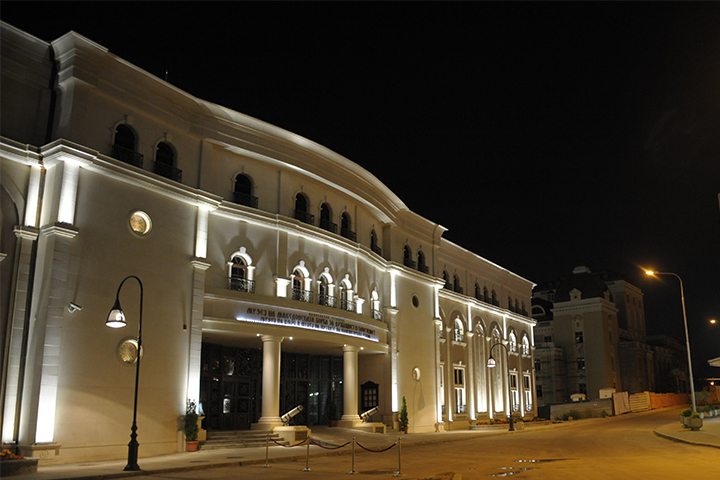
Museo dell’Olocausto
Centro memoriale dell’olocausto degli ebrei di Macedonia
Il Museo dell’olocausto è una struttura recentemente costruita nel luogo del vecchio quartiere degli ebrei, vicino al Ponte di Pietra, come uno dei quattro musei del genere nel mondo, ovvero a Gerusalemme, Washington e Berlino. Dedicato agli ebrei macedoni (7.148 persone) deportati nell’accampamento di concentrazione Treblinka in Polonia durante la Seconda guerra mondiale. Nell’intero è allestita una mostra permanente sulla vita degli ebrei in Macedonia e sui Balcani.
Museo dell’arte contemporanea
Il museo dell’arte contemporanea si trova alla Fortezza Kale. É stato costruito come donazione del governo polacco, dopo il terremoto a Skopje nel 1963. Comprende una superficie di 5.000 m2 in tre ali collegate tra di loro. Ci si trovano le sale per le mostre permanenti, sale per le eposizioni temporanee, proiezioni video e dei film, biblioteca e archivio, officina di conservazione, magazzini, amministrazioni ed altri servizi accessori. Dispone di una preziosa collezione internazionale e dà un panorama rappresentativo nell’arte contemporanea macedone.
VODNO
Uno spettacolo verso Skopje e una corsa irrepetibile con la funivia da Sredno Vodno alla Croce del Millennio
Vodno è un monte che erge sopra Skopje ad un’altitudine di 1.061 metri. Ci si trova la Croce del Millennio, il monastero San Pantelejmon, e Vodno dispone anche di un parco- bosco, case di montagna, strutture di ristorazione, buoni sentieri di escursionisti, parcheggi per le automobili e spettacolari viste panoramiche. Dal monte Vodno si vede quasi tutta la Vallata di Skopje e la città di Skopje. Vodno rappresenta una delle località più frequentate nei dintorni di Skopje.
Nel giugno del 2011 è stata messa in funzione la funivia da Sredno Vodno (Vodno Medio) alla Croce del Millennio, il cui tracciato è di 1.750 metri e sale da 570 a 1.068 metri di altitudine. La funivia dispone di 28 cabine con un peso massimo di 640 kg e capacità per otto persone, nonche’ due cabine con capacità di quattro persone. Le cabine dalla parte esterna sono attrezzate anche con i portabici.
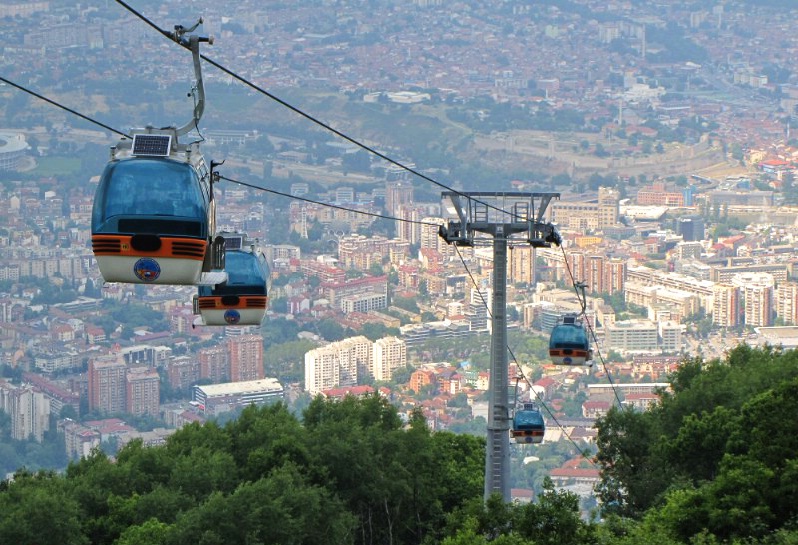
La Croce del Millennio
Con 66 metri di altezza è l’oggetto più alto in Macedonia
La Croce del Millennio è stata costruita nel 2000 nella cima Krstovar (1.061 metri altitudine) sul Vodno, nella vicinanza di Skopje, nell’ occasione del passaggio dal secondo al terzo millennio.
Il Monastero San Pantelejmon, Gorno Nerezi (XII secolo)
L’inizio del Rinascimento e la pittura a fresco, 140 anni prima della nascita del Rinascimento in Italia
Tutta la città di Skopje e i suoi dintorni si possono vedere da una prospettiva a volo d’ uccello, come in uno schermo dal monastero S. Pantelejmon dal cuore di Vodno. Questo monastero ha un valore importante nella pittura a fresco in Macedonia. In questo monastero inizia il rinascimento nella pittura a fresco, quasi un secolo prima del rinascimento in Italia di Giotto.
Il monastero fu costruito nel 1164 nel periodo della dinastia bizantina dei Comneni . Così è inciso nella piastra di marmo , messa sopra il portone. I migliori maestri e zoografi di quel tempo fecero il loro capolavoro. Il muro è di pietra e mattoni in forma di croce in uno spazio rettangolare e cinque cupole.
Il monastero aveva sopravvisuto un incendio, un terremoto, distruzioni e saccheggi, ma è rimasto come un testimone della ricca vita ecclesiastica e culturale del XII secolo e del centro ecclesiastico metropolitano di Skopje. Questo monastero fa parte di tutte le edizioni di enciclopedie più importanti di cultura e arte a livello mondiale.
Gli affreschi del XII secolo rappresentano i santi guerrieri (prima parte), le feste più importanti (seconda parte) e l’affresco più notevole e “Il Pianto della Madonna” e “ la liberazione di Gesù dalla croce” . Sono meravigliose anche le opere ”L’ascesa della Madonna”, “ Incontro” , “ “La Madonna e Gesù Cristo “ e “San Pantelejmon”.
MATKA
Bellezza naturale sopra Skopje e complesso di strutture di un godimento piacevole
Matka, la valle delle farfalle è una località molto particolare vicino a Skopje. Si trova alla parte nord-occidentale di Skopje, all’uscita del fiume Tresca dalla lunga Gola di Shishevo. Matka è un complesso di un canyon profondamente inciso e la prima accomulazione artificiale sulla penisola Balcanica, costruita nel 1938. Vi si trovano più cavi, centro di allenamento alpinistico, un corso d’acqua per il kayak su acque bianche, complesso di più monasteri, ostelli di montagna, ristoranti, strutture di ristorazione, natura mozzafiato ricca di flora e fauna. Il bacino artificiale occupa una superficie di 0,25 km2. É lungo 5,9 km e 2,6 milioni m3 di area utilizzabile. La sua funzione è di produrre l’elettricità per la città di Skopje.
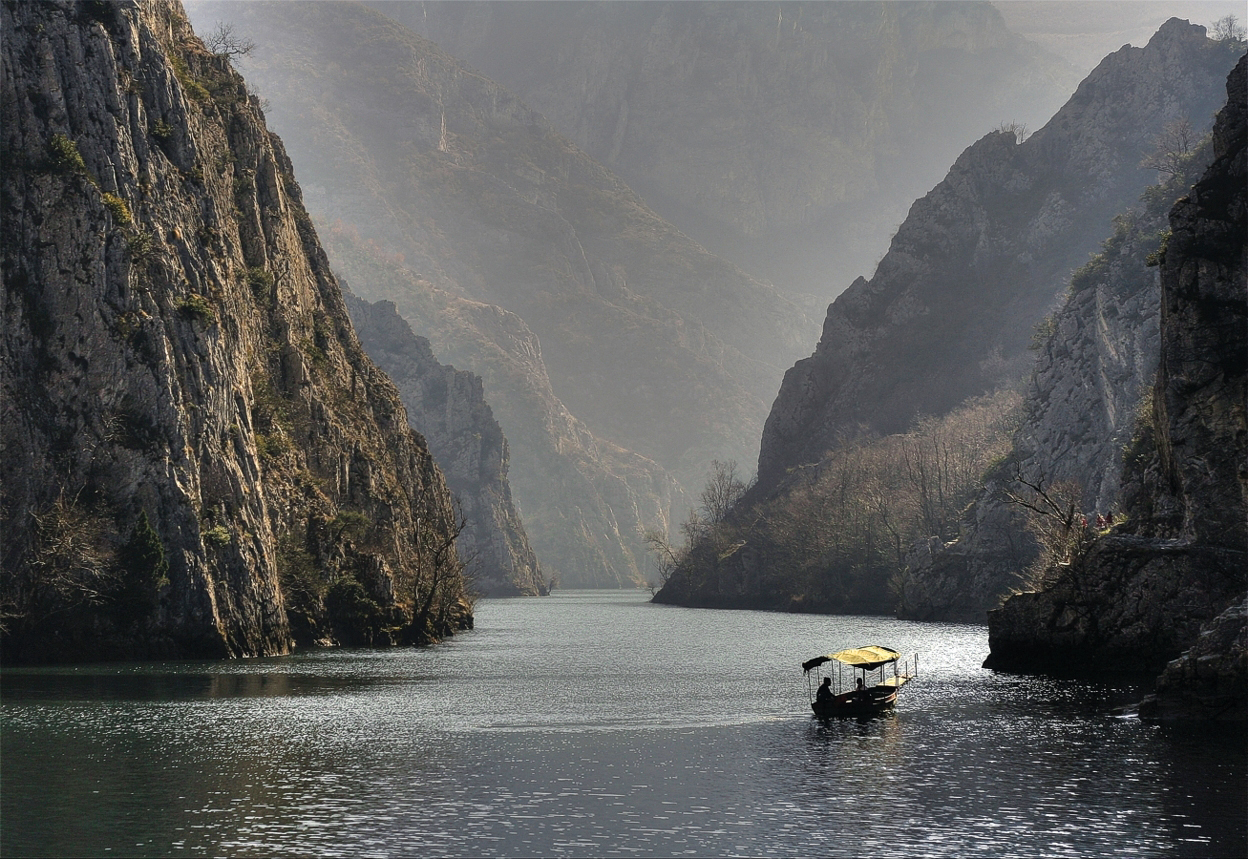
Il Monastero San Andrej, Matka (1389)
Una forma raramente conservata della croce libera in Macedonia
Il monastero è collocato nel Canyon Treska. Fu costruito da Andreja, il secondo figlio del re Volkashin, nel 1389. Ha una forma di trifoglio con la cupola media in arco. I pittori degli affreschi sono gli zoografi mitropolita Jovan e il monaco Grigorij i quali hanno eseguito le opere anche nel monastero di Zrze.
Gli affreschi nel S.Andrej sono una novità nella pittura medievale macedone e un segno del nuovo stile nel tempo della comparsa del hesychia nel monasticismo. In tre zone sono rappresentati gli affreschi dei guerrieri santi: Gjorgji, Dimitrij, Teodor Tiron e Teodor Stratilat in figure intere, nonche’ gli affreschi con scene della vita del Gesù Cristo. Le iscritte sono in alfabeto greco e slavo ecclesiastico.
Il villaggio neolitico Tumba Madjari
Località archeologica e museo all’aperto
La località si trova nel quartiere odierno Chento e rappresenta l’insediamento neolitico più importante nella Vallata di Skopje dal periodo neolitico- la prima età della pietra. La vita qui si svolgeva in continuità tra il 6000 e 4300 anno a. C, buono stato economico e prosperità culturale nel periodo neolitico medio (5800-5200 a.C). Sono trovati molti reperti di ceramica, esposti nel Museo della Macedonia.
Dal 2008 al 2010 sono state costruite alcune case nello spirito dell’architettura neolitica, in sui è rappresentato inventorio, con lo scopo di ricostruire la vita dell’uomo neolitico. Le case sono in legno, gramigna, paglia, coperte da fango e costruite secondo le tradizioni neolitiche. L’ordine delle strutture scoperte fa riferimento ad un’organizzazione ben concepita, strettamente collegata all’importanza e il ruolo del tempio.
La Madre Maggiore- la Dea della fertilità
In Tumba Madjari per la prima volta è stata scoperta la figura in terracotta della Madre Maggiore, rappresentata in un modo finora sconosciuto tra le culture neolitiche dagli altri territori balcanici. Le dimensioni impressionanti di 39 cm. di altezza, una posizione calma di veglia sopra il focolaio, ne fanno una figura esclusiva. La parte inferiore della figura, rappresenta la casa protetta da lei. Il neolitico macedone si caraterizza con un culto verso la Madre Maggiore. Figure di questo tipo sono state trovate quasi in tutte le località neolitiche in Macedonia, ma forse la più bella è quella della Madre Maggiore di Tumba Madjari.
Skupi
Città dal periodo romano e tardo antico
Skupi è un sito archeologico, il quale si trova a cinque chilometri al nord-ovest di Skopje, vicino al villaggio Zlokukjani. Le ricerche archeologiche dal 1966 a oggi vengono fatte dal Museo della città di Skopje. Finora sono ricercate le mura, il teatro, la basilica civile, la villa civile, il bagno civile, la via cardo, la basilica cristiana, nonche’ parti della necropoli orientale e occidentale.
Questa città romana probabilmente fu fondata nel periodo tra il XII e il XI secolo a.C. Nel corso del II secolo, Skupi ottenne l’aspetto rappresentativo in cui il teatro monumentale aveva la posizione centrale. Nel IV secolo fu notato un aumento delle attività edili, quando fu costruita la Basilica, verso la fine del IV secolo o all’inizio del V secolo fu costruita un’altra chiesa paleocristiana.
Nel 518 Skupi fu colpita da un forte terremoto, dopo di che terminò la sua vita urbana, anche se ci sono indizi che la vita in una forma di piccolo insediamento rurale continuò fino al X e XI secolo.
Acquadotto
Attraverso l’acquadotto l’acqua veniva versata da fonti della montagna Skopjska Crna Gora
Si trova a due chilometri nella parte occidentale di Skopje. Fu costruito da pietra e mattoni e oggi conta 55 archi appoggiati su pillastri massicci. Anche se si collegava con Skupi, a causa della costruzione simile di Kurshumli An, si considera che fosse costruita nel XV secolo, quando Skopje iniziò ad aumentare le sue costruzioni islamiche, per cui funzionamento ci volevano grandi quantità di acqua pura. La quantità dell’acqua era costante e con una portata garantita durante tutto l’anno.
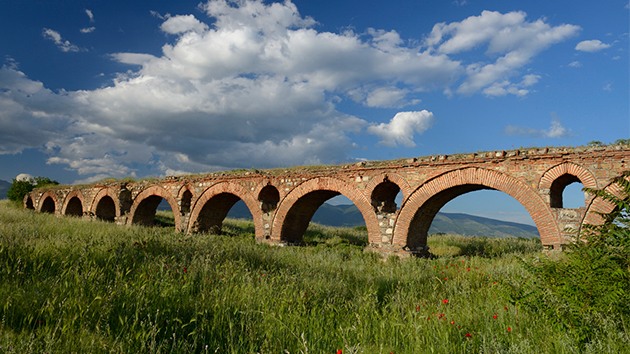
Le terme di Katlanovo
Le terme di Katlanovo si trovano a circa 25 km da Skopje, molto vicino a Katlanovo, alla sponda destra del fiume Pcinja, ad un’altitudine dei 230 metri. Ci sono più fonti. La fonte principale fornisce 15 l/ sec. La temperatura dell’acqua è di circa 50°C. Secondo il contenuto chimico, le acque sono alcaline e ipertermali e sono adatti per curare le malattie di fiele e fegato, dell’apparato respiratorio, del metabolismo, del tratto intestinale, delle malattie del cuore ecc. Nel complesso termale ci sono strutture turistiche e di ristorazione, nonche’ sanitarie, con diversi tipi di turismo: curativo, ricreativo, sportivo, pesca e caccia.
Il Monastero di Marko
San Dimitrij, v. Sushica (XIV secolo)
Pace spirituale e tranquillità durante i secoli
A circa 20 km da Skopje, accanto al Fiume di Marko, vicino al villaggio Sushica, si trova il Monastero di Marko, chiamato così per i fondatori il re Volkashin e suo figlio Marko. I dati sulla costruzione della chiesa (1345) e sui fondatori del monastero si trovano nell’ingresso della parte del sud, nell’interno della chiesa. La chiesa ha la forma di una croce incisa, costruita da pietra e mattoni.
Gli affreschi datano dal XIV secolo. Rappresentano ricche illustrazione di akathistos della Madonna, i miracoli di Cristo, grandi feste e singole figure di santi, angeli, profeti, eremiti e guerrieri. L’affresco più famoso è il Lamento di Rachel, in cui è rappresentato il dramma umano attraverso l’omicidio dei bambini a Betlemme.
Il monastero dispone di un grande partimonio ecclesiastico, culturale e storico: icone, manoscritti e libri, oggetti della chiesa e relitti. Qui veniva svolta una vita attiva dei monaci con delle attività di trascrizione dei testi ed educazione. Nel XIX secolo igumeno del monastero era il fautore del risorgimento macedone e lo scrittore Kiril Pejchinovikj, il quale nel monastero fondò una scuola e scrisse il suo famoso libro Specchio.
Il Centro Sportivo Boris Trajkovski
É il maggiore complesso sportivo in Macedonia. La sala maggiore dispone di capacità di 8.000 spettatori per seguire il pallacanestro e 10.000 per concerti ed altre manifestazioni. Dispone anche di piscina, sala di hockey, ping-pong, fitness, bowling, sauna. Qui è stato svolto il campionato europeo femminile di pallamano nel 2008.
Lo Stadio nazionale Filippo II di Macedonia
Stadio multifunzionale, il quale viene utilizzato di più per le partite di calcio, con la massima disponibilità di 36.400 spettatori. Viene usato dalle squadre di calcio Rabotnichki e Vardar, nonche’ la squadra nazionale. La costruzione dello stadio della città è stata iniziata nel 1978 con la costruzione della tribuna del sud. Nel 2008 è distrutta la vecchia tribuna del nord e ne è stata costruita una nuova secondo i superiori standard della FIFA. Dopo la ricostruzione della tribuna del sud nel 2011, sono messe in funzione anche quelle dell’est ed ovest.
Manifestazioni
Skopje Jazz Festival
Ottobre, Skopje
Il Festival di Jazz di Skopje è una manifestazione iniziata nel 1982 e da allora si svolge in continuità sempre nella prima metà del mese di ottobre. Il festival si caratterizza di alta qualità perche’ ne fanno parte solo i migliori musicisti del mondo. Questo festival è stato nominato superbrand della Repubblica di Macedonia nel 2009.
L’Estate di Skopje
21 giugno- 31 luglio, Skopje
A partire dal 1980, il concetto della manifestazione comprende concerti musicali, spettacoli dell’opera lirica, teatri e balletti, esposizioni di dipinti e foto, programma cinematografico, progetti multimediali, nonche’ ospiti dall’estero. In quasi trenta diverse località, ci sono palcoscenici all’ aperto, alla Fortezza di Skopje, nel Vecchio Bazar, Kurshumli An, Lungofiume del Vardar, parco della città, teatri e gallerie.
Le Serate di opera lirica di maggio
9-31 maggio, Skopje
Con la tradizione dal 1972, il festival è uno dei più frequentati a Skopje. Il palco del Teatro dell’opera e balletto ospitano diversi spettacoli, non solo di opere liriche e balletti, ma anche concerti e performance di simfonie. I partecipanti regolari sono artisti lirici e ballerrini sia provenienti dai paesi vicini, che dal mondo, nonche’ i gruppi dell’Opera e Balletto Macedone.
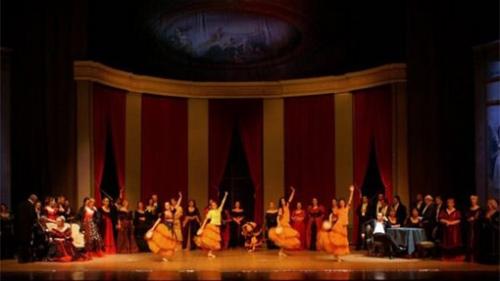
Baskerfest
Maggio-giugno, Skopje
Festival internazionale di artisti per strada, che si svolge in diverse località a Skopje. É un festival gratuito, per cui non si pagano i biglietti- il prezzo unico è il contributo a volontà nei cappelli degli artisti. Una parata di carnevale, composta da acrobati, clown, comici, camminatori su bastoni, maghi, giocolieri, burattinai, vignettisti, guitti, danzatori nazionali, musicisti, completati da diverse maschere, costumi e musica.
Pivolend ( Il festival della birra)
Settembre, Skopje
Con circa 300.000 visitatori, il festival rappresenta una meta per coloro che vogliono un buon divertimento e contatto con i maggiori produttori di birra, abbinata ad ottimo cibo dai ristoranti locali e buona musica.
Clicca qui per vedere la lista di alloggi a Skopje
Clicca qui per vedere l'elenco delle Guide Turistiche a Skopje
Clicca qui per vedere l'elenco delle agenzie di viaggio a Skopje
Gola di Matka
La Gola di Matka è uno dei luoghi più caratteristici e visivamente aff asci- nanti che si possa trovare in Macedonia. È situata a soli 15 Km dalla capi- tale Skopje ed è una meta tradizionale per trascorrere i fi ne settimana. È una gola naturale del fi ume Treska caratterizzata da una forma particolare, dalla varietà del rilievo, da ripide colline e da rocce verticali. La gola di Matka ha da sem- pre attratto un gran numero di amanti della natura e di esploratori perché rap- presenta un serbatoio di specie di animali rari (come le aquile dalla testa bianca e quindici specie di farfalle che vivono solo in questo territorio) e altre specie endemi- che di vegetali e piante. Il Parco Speleologico è uno dei più aff ascinanti d’Europa.

In quest’area si trovano una decina di grotte della lunghezza dai 20 ai 176 metri. La più singolare è la grotta sotterranea denominata Vrelo, che racchiude al suo interno due laghi ed è ricca di stalattiti. All’interno troneggia l’enorme stalagmite a forma di pigna che si accumu- la da 2700 anni. Attualmente la grotta Vrelo con i suoi 212 metri di profondità è la grotta sommersa più profonda dei Balcani ed è la seconda in Europa.

La profondità non è stata ancora completamente accertata ed è a tutt’oggi oggetto di esplorazioni. Gli amanti degli sport estremi hanno la possibilità di praticare l’arrampicata sporti- va o l’alpinismo o di attraversare in Kayak le tumultuose acque del fi ume. Proprio qui lungo il corso del fi ume Treska si è svolto nel 1975 il campionato mondiale di Kayak in acque bianche.

Tutti quanti, nessuno escluso, possono godersi una gita in barca lungo il lago artifi ciale più antico della Macedonia, visitando le quattro chiese e monasteri che si trovano nelle vicinanze. Nella gola di Matka ci sono svariati sentieri intrecciati e collegati tra loro, in modo da rendere agevole raggiungere la destinazione stabilita. A Matka puoi solo perderti fra le tue fantasie e i sospiri provocati da ciò che ammiri.
ita+1 Day Tour of Skopje and the Matka Canyon, a Nature Phenomenon
1 Day Tour of Skopje and the Matka Canyon, a Nature Phenomenon
· Start of tour - We meet at the Museum of the city of Skopje. Our friendly tour guides will provide you will information regarding navigating your way around Skopje. You will then proceed with a walk along the famous ‘Macedonia Street’ towards the main city square. You will pass the Memorial House of Mother Teresa which was built in her honour as she was born in Skopje in 1910 and was awarded a Nobel Peace Prize for her humanitarian efforts.
· City Square - As you walk around the heart of Skopje – its city square, you will be treated with a guide of the monuments and buildings that paint a picture of Macedonia’s rich culture and history. You will then continue towards the Old Bazaar and pass over the greatest river in Macedonia, Vardar, via one of the most recognizable symbols of Skopje – the Stone Bridge.
· Old Bazaar - The first thing you will notice once entering the Old Bazaar is a sense of ancient times. Where, for centuries it has been buzzing with people from all over the Balkan region, trading their wares and services. You will be guided through this ancient Bazaar and experience the feeling of stepping back in time. We will have lunch at one of the local restaurants.
· The Old Town - Your experience of ancient times will only be reinforced by walking around the Old Town and hearing the stories of the Grand Fortress Kale that bears over the city. With this we finish the city tour part and head to Canyon Matka.
· Matka Canyon - Our next stop is the Matka Canyon – an outstanding work of nature of which some claim to be home to the largest underwater cave in the world. A claim that has yet to be substantiated as no one has been able to get to the bottom! Matka Canyon boasts outstanding preserved natural and geographical characteristics, in which rare endemic species have found their escape. Spot an eagle flying high in the sky, enjoy a boat ride along the magnificent gorge and explore the famous Vrelo cave full of stalagmites.
· Arrive back in Skopje

Tour organized by:
tel:+38922400513
ita+1 day tour from mount Vodno to the Matka canyon
Hiking from the city Skopje across the ridge of mount Vodno to the canyon Matka.
Interesting hiking fulfilled with moving through nature and a view on Skopje city, which gives the tour a combined urban-outdoor feeling.
Tour organized by:
email: [email protected]
tel: +389 70 319 301
Czy wiedzieliście Państwo, że Matka Teresa urodziła się w Skopje?
Czy wiedzieliście Państwo, że Matka Teresa urodziła się w Skopje?
Urodzona jako Agnes Gondża Bojadżiu 26 sierpnia 1910 roku w Skopje, stolicy Macedonii, a ówcześnie w Imperium Osmańskim, była najmłodszym z trójki dzieci. Jej rodzina była pochodzenia albańskiego.

W wieku dwunastu lat zrozumiała, że to, co najbardziej ze wszystkiego chciałaby robić, to pomagać ubogim. Podjęła decyzję, że będzie się kształcić do pracy misjonarskiej i w wieku dziewiętnastu lat wyjechała do Indii, aby przystąpić do zakonu Sióstr z Loreto, wspólnota irlandzka sióstr z misją w Kalkucie. W 1928 roku rozpoczęła postulat, a pierwsze śluby zakonne złożyła w 1931 roku. Zainicjowała różne projekty, jak rehabilitacja mieszkańców biednych osiedli, domy dziecka, hospicja , kliniki i kolonie dla chorych na leprę itp. Dzisiaj misjonarze miłosierdzia działają na całym świecie i zajmują się pracą humanitarną w wielu państwach Afryki, Azji oraz Ameryki Południowej.
Dzieło Matki Teresy jest uznane przez świat, otrzymała wiele nagród, m.in. prestiżową Pokojową Nagrodę Nobla w 1979 roku; Nagrodę Pokoju Jana XXII, którą w 1971 r. przyznał jej papież Paweł VI; Order Bahrat Ratna w 1980 r. Matka Teresa zmarła 5 września 1997 roku
Dom Pamięci Matki Teresy
Pragnienie Macedonii, by oddać hołd jednej z najbardziej znanych osobistości, jak też zdobywcy nagrody Nobla zostało spełnione 30 stycznia 2009 roku, otwarciem Domu Pamięci poświęconego Matce Teresie.
Dom Pamięci Matki Teresy jest organizacją niedochodową finansowaną przez rząd Republiki Macedonii.
Lokalizacja muzeum nie jest przypadkowa. Dokładnie w tym miejscu znajdował się stary kościół katolicki pod wezwaniem Najświętszego Serca Jezusowego. W tym miejscu Gondża Bojadżiu była ochrzczona, następnego dnia po jej narodzinach, 27 sierpnia 1910 roku oraz gdzie znalazła wewnętrzny spokój po śmierci swojego ojca.
To miejsce ma ogromne znaczenie dla młodej Gondży i wpływa na rozwój jej charakteru oraz pragnienie pomagania ubogim. Jeszcze jako dziecko śpiewała w chórze kościoła katolickiego i uczestniczyła w organizacjach niosących pomoc ubogim. Tak też to miejsce stanowi symboliczny most łączący małą Gondżę z jednym z największych altruistów na świecie, to jest z Matką Teresą.
Matka Jezioro & kanion
Matka jest jednym z najbardziej rozpoznawalnych i najpiękniejszych krajobrazów w Macedonii. Jest tylko oddalona 15 km od stolicy i jest nieuniknionym miejscem weekendowej rekreacji. Jest to naturalny kanion rzeki Treska , która charakteryzuje się specyficznym kształtem różnorodnym reliefem o stromych skalistych zboczach i pionowych masywów skalnych. Kanion Matka zawsze przyciąga wielu miłośników przyrody i badaczy, jako naturalny rezerwat rzadkich gatunków zwierząt (takich jak bielików orłów i piętnaście gatunków motyli, które żyją tylko na tym terenie) i endemicznych gatunków roślin i ziół.
Park speleologiczny jest jednym z najbardziej fascynujących w Europie. Na tym obszarze znajduje się dziesięć jaskiń o długości od 20 do 176 metrów. Spośród nich najbardziej uderzająca jest podziemna jaskinia Wrelo, której wnętrze posiada dwa jeziora i jest bogata w stalaktyty. Dominuje ogromny stalagmit w kształcie szyszki, który się odkłada 2700 lat. Z głębokością 212 metrów, w momencie Wrelo jest najgłębsza podwodną jaskinią na Bałkanach, a drugą w Europie. Głębokość nie została jeszcze w pełni wykryta i nadal jest badana.
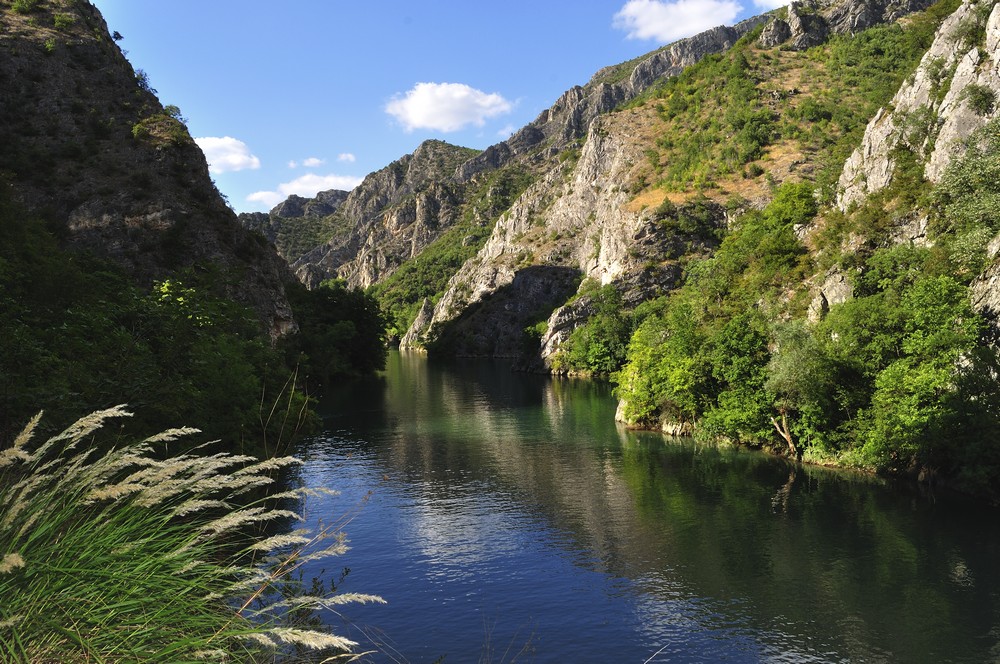
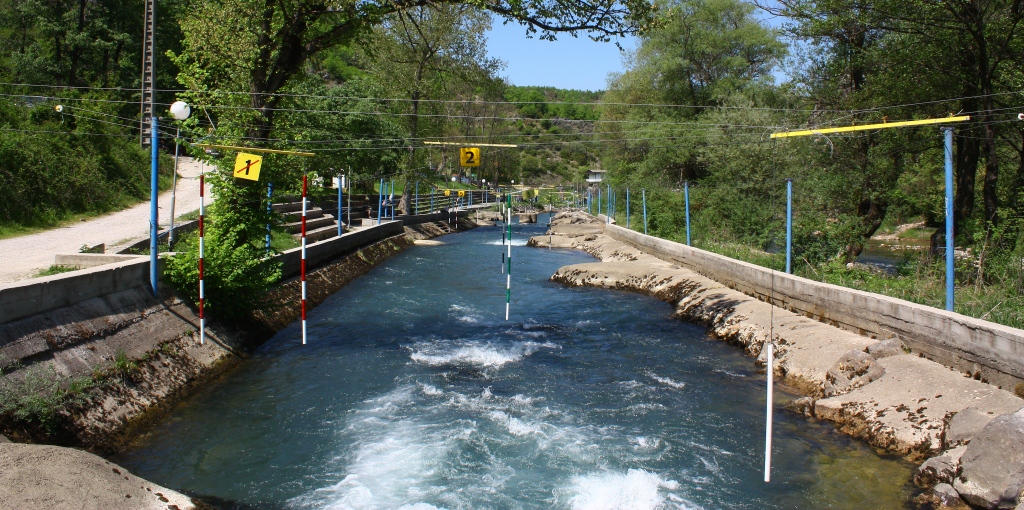
Miłośnicy bardziej ekstremalnych sportów mają możliwość uprawiania wspinaczki sportowej i alpinizmu lub spływu kajakowego. Tutaj, na szlaku rzeki Treski odbyły się Mistrzostwa świata kajakarskie na dzikich wodach w 1975 roku. Wszyscy bez wyjątku mogą wybrać się na spacer łodzią po najstarszym sztucznym jeziorze w Macedonii, a w bezpośrednim sąsiedztwie znajdują się 4 cerkwie i monastyry. Na Matka przeplata się i łączy wiele ścieżek, więc łatwo jest dotrzeć do pożądanego celu. Możesz się tylko zgubić w snach i westchnieniach spowodowanych tym, co Matka ci oferuje.
pol+1 Day Tour of Skopje and the Matka Canyon, a Nature Phenomenon
1 Day Tour of Skopje and the Matka Canyon, a Nature Phenomenon
· Start of tour - We meet at the Museum of the city of Skopje. Our friendly tour guides will provide you will information regarding navigating your way around Skopje. You will then proceed with a walk along the famous ‘Macedonia Street’ towards the main city square. You will pass the Memorial House of Mother Teresa which was built in her honour as she was born in Skopje in 1910 and was awarded a Nobel Peace Prize for her humanitarian efforts.
· City Square - As you walk around the heart of Skopje – its city square, you will be treated with a guide of the monuments and buildings that paint a picture of Macedonia’s rich culture and history. You will then continue towards the Old Bazaar and pass over the greatest river in Macedonia, Vardar, via one of the most recognizable symbols of Skopje – the Stone Bridge.
· Old Bazaar - The first thing you will notice once entering the Old Bazaar is a sense of ancient times. Where, for centuries it has been buzzing with people from all over the Balkan region, trading their wares and services. You will be guided through this ancient Bazaar and experience the feeling of stepping back in time. We will have lunch at one of the local restaurants.
· The Old Town - Your experience of ancient times will only be reinforced by walking around the Old Town and hearing the stories of the Grand Fortress Kale that bears over the city. With this we finish the city tour part and head to Canyon Matka.
· Matka Canyon - Our next stop is the Matka Canyon – an outstanding work of nature of which some claim to be home to the largest underwater cave in the world. A claim that has yet to be substantiated as no one has been able to get to the bottom! Matka Canyon boasts outstanding preserved natural and geographical characteristics, in which rare endemic species have found their escape. Spot an eagle flying high in the sky, enjoy a boat ride along the magnificent gorge and explore the famous Vrelo cave full of stalagmites.
· Arrive back in Skopje

Tour organized by:
tel:+38922400513
pol+1 day tour from mount Vodno to the Matka canyon
Hiking from the city Skopje across the ridge of mount Vodno to the canyon Matka.
Interesting hiking fulfilled with moving through nature and a view on Skopje city, which gives the tour a combined urban-outdoor feeling.
Tour organized by:
email: [email protected]
tel: +389 70 319 301
rus+1 Day Tour of Skopje and the Matka Canyon, a Nature Phenomenon
1 Day Tour of Skopje and the Matka Canyon, a Nature Phenomenon
· Start of tour - We meet at the Museum of the city of Skopje. Our friendly tour guides will provide you will information regarding navigating your way around Skopje. You will then proceed with a walk along the famous ‘Macedonia Street’ towards the main city square. You will pass the Memorial House of Mother Teresa which was built in her honour as she was born in Skopje in 1910 and was awarded a Nobel Peace Prize for her humanitarian efforts.
· City Square - As you walk around the heart of Skopje – its city square, you will be treated with a guide of the monuments and buildings that paint a picture of Macedonia’s rich culture and history. You will then continue towards the Old Bazaar and pass over the greatest river in Macedonia, Vardar, via one of the most recognizable symbols of Skopje – the Stone Bridge.
· Old Bazaar - The first thing you will notice once entering the Old Bazaar is a sense of ancient times. Where, for centuries it has been buzzing with people from all over the Balkan region, trading their wares and services. You will be guided through this ancient Bazaar and experience the feeling of stepping back in time. We will have lunch at one of the local restaurants.
· The Old Town - Your experience of ancient times will only be reinforced by walking around the Old Town and hearing the stories of the Grand Fortress Kale that bears over the city. With this we finish the city tour part and head to Canyon Matka.
· Matka Canyon - Our next stop is the Matka Canyon – an outstanding work of nature of which some claim to be home to the largest underwater cave in the world. A claim that has yet to be substantiated as no one has been able to get to the bottom! Matka Canyon boasts outstanding preserved natural and geographical characteristics, in which rare endemic species have found their escape. Spot an eagle flying high in the sky, enjoy a boat ride along the magnificent gorge and explore the famous Vrelo cave full of stalagmites.
· Arrive back in Skopje

Tour organized by:
tel:+38922400513
rus+1 day tour from mount Vodno to the Matka canyon
Hiking from the city Skopje across the ridge of mount Vodno to the canyon Matka.
Interesting hiking fulfilled with moving through nature and a view on Skopje city, which gives the tour a combined urban-outdoor feeling.
Tour organized by:
email: [email protected]
tel: +389 70 319 301
Matka jezero & kanjon
Speleološki park - jeden izmed najbolj fascinantnih v Evropi
Matka je eden izmed najbolj prepoznavnih in najrazkošnih krajev v Makedoniji. Nahaja se le 15 kilometrov od glavnega mest in je neizogiben kraj za vikend rekreacijo.
To je naravni kanjon reke Treske, ki je značilen po posebni obliki, raznovrstnosti reliefa, strmih pobočjih i vertikalnih skalnatih masivih. Matka vedno pritegne veliko ljubiteljev narave in raziskovalcev, zato ker je naravni rezervat retkih živalskih oblik (kot so beloglavi orel in petnajst vrst metuljev, ki živijo samo na tem področju) i endemičnih vrst rastlin in zelišč.
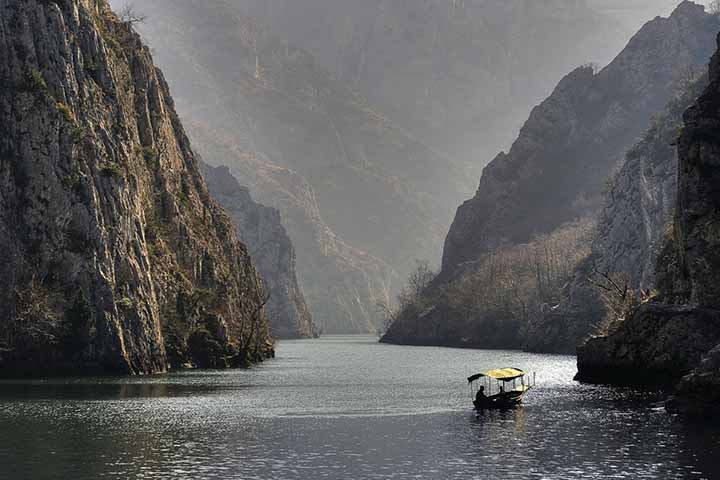

Speleološki park je eden izmed najbolj fascinantnih v Evropi. Na tem prostoru je več jam dolgih med 20 in 176 metrov. Najbolj osupljiva med njimi je podzemska jama Vrelo, ki v svoji notranjosti skriva dva jezera in veliko kapnikov. Dominira ogromen kapnik v okliki storža ki se useda že 2700 let.
Z globino 212 metrov je Vrelo trenutno najbolj globoka podvodna jama na Balkanu in druga v Evropi. Globina še ni celotno odkrita, ter se še zmeraj raziskuje. Ljubitelji bolj ekstremnih športov tukaj imajo priložnost uživati v športnem plezanju in alpinizmu, ali kajaku na divjih vodah.
Svetovno prvenstvo v kajaku
Prav tukaj na stezi v reki Treski je leta 1975 potekalo Svetovno prvenstvo v kajaku na divjih vodah. Vsi, brez izjeme lahko uživajo tudi v izletu s čolnom po najstarejšem umetnem jezeru v Makedoniji, v njegovi neposredni bližini pa so 4 cerkve in samostani.
V Matki se prepletajo in povezujejo številne steze, tako da je enostavno priti do željenega cilja. Lahko se izgubite le v sanjah in vzdihih ki jih povzroča to, kar vam Matka ima za ponuditi.

sol+1 Day Tour of Skopje and the Matka Canyon, a Nature Phenomenon
1 Day Tour of Skopje and the Matka Canyon, a Nature Phenomenon
· Start of tour - We meet at the Museum of the city of Skopje. Our friendly tour guides will provide you will information regarding navigating your way around Skopje. You will then proceed with a walk along the famous ‘Macedonia Street’ towards the main city square. You will pass the Memorial House of Mother Teresa which was built in her honour as she was born in Skopje in 1910 and was awarded a Nobel Peace Prize for her humanitarian efforts.
· City Square - As you walk around the heart of Skopje – its city square, you will be treated with a guide of the monuments and buildings that paint a picture of Macedonia’s rich culture and history. You will then continue towards the Old Bazaar and pass over the greatest river in Macedonia, Vardar, via one of the most recognizable symbols of Skopje – the Stone Bridge.
· Old Bazaar - The first thing you will notice once entering the Old Bazaar is a sense of ancient times. Where, for centuries it has been buzzing with people from all over the Balkan region, trading their wares and services. You will be guided through this ancient Bazaar and experience the feeling of stepping back in time. We will have lunch at one of the local restaurants.
· The Old Town - Your experience of ancient times will only be reinforced by walking around the Old Town and hearing the stories of the Grand Fortress Kale that bears over the city. With this we finish the city tour part and head to Canyon Matka.
· Matka Canyon - Our next stop is the Matka Canyon – an outstanding work of nature of which some claim to be home to the largest underwater cave in the world. A claim that has yet to be substantiated as no one has been able to get to the bottom! Matka Canyon boasts outstanding preserved natural and geographical characteristics, in which rare endemic species have found their escape. Spot an eagle flying high in the sky, enjoy a boat ride along the magnificent gorge and explore the famous Vrelo cave full of stalagmites.
· Arrive back in Skopje

Tour organized by:
tel:+38922400513
sol+1 day tour from mount Vodno to the Matka canyon
Hiking from the city Skopje across the ridge of mount Vodno to the canyon Matka.
Interesting hiking fulfilled with moving through nature and a view on Skopje city, which gives the tour a combined urban-outdoor feeling.
Tour organized by:
email: [email protected]
tel: +389 70 319 301
Matka jezero i kanjon
Speleološki park - jeden izmed najbolj fascinantnih v Evropi
Matka je eden izmed najbolj prepoznavnih in najrazkošnih krajev v Makedoniji. Nahaja se le 15 kilometrov od glavnega mest in je neizogiben kraj za vikend rekreacijo.
To je naravni kanjon reke Treske, ki je značilen po posebni obliki, raznovrstnosti reliefa, strmih pobočjih i vertikalnih skalnatih masivih. Matka vedno pritegne veliko ljubiteljev narave in raziskovalcev, zato ker je naravni rezervat retkih živalskih oblik (kot so beloglavi orel in petnajst vrst metuljev, ki živijo samo na tem področju) i endemičnih vrst rastlin in zelišč.


Speleološki park je eden izmed najbolj fascinantnih v Evropi. Na tem prostoru je več jam dolgih med 20 in 176 metrov. Najbolj osupljiva med njimi je podzemska jama Vrelo, ki v svoji notranjosti skriva dva jezera in veliko kapnikov. Dominira ogromen kapnik v okliki storža ki se useda že 2700 let.
Z globino 212 metrov je Vrelo trenutno najbolj globoka podvodna jama na Balkanu in druga v Evropi. Globina še ni celotno odkrita, ter se še zmeraj raziskuje. Ljubitelji bolj ekstremnih športov tukaj imajo priložnost uživati v športnem plezanju in alpinizmu, ali kajaku na divjih vodah.
Svetovno prvenstvo v kajaku
Prav tukaj na stezi v reki Treski je leta 1975 potekalo Svetovno prvenstvo v kajaku na divjih vodah. Vsi, brez izjeme lahko uživajo tudi v izletu s čolnom po najstarejšem umetnem jezeru v Makedoniji, v njegovi neposredni bližini pa so 4 cerkve in samostani.
V Matki se prepletajo in povezujejo številne steze, tako da je enostavno priti do željenega cilja. Lahko se izgubite le v sanjah in vzdihih ki jih povzroča to, kar vam Matka ima za ponuditi.

Canyon Matka
Matka Canyon - an attractive tourist destination in Skopje
Matka Canyon is a canyon on the river Treska, a right tributary of Vardar, covering an area of about 5,000 hectares and located 17 km southwest of Skopje. According to the morphogenetic characteristics it represents a ravine-breaker. Karst forms deserve special attention in this area. These are the ten caves with a length of 20 to 176 meters and two precipices with a depth of up to 35 meters.
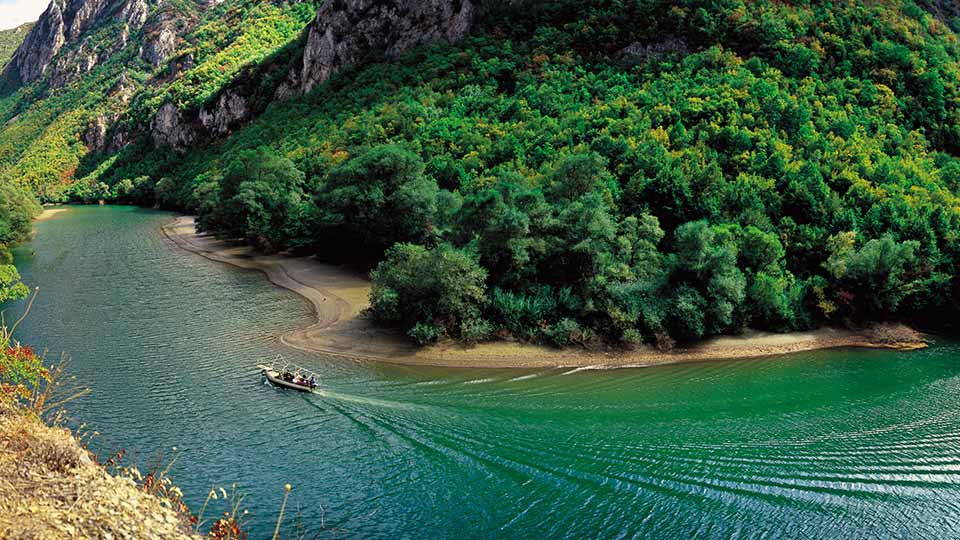
Canyon Matka-relict and endemic plants and animals
Matka Canyon is one of the largest refugial centers during the glacial period, which contributed to the presence of many relict and endemic plants and animals today. Of the total number of 1000 species of plants, 20% are endemics or relicts. Among the tertiary relics, more important are the violet (Viola kosaninii) and natalie Ramonda (Ramonda nathaliae).
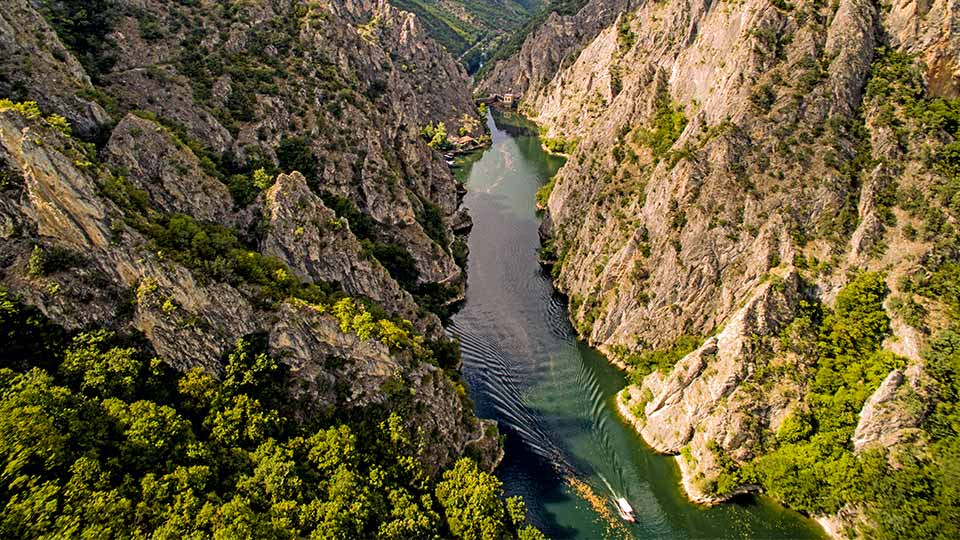
Two new species of true spiders and five false scorpions were discovered at the site Matka. In the Matka Canyon 119 species of daily and 140 species of night butterflies are registered. It is important to note that 77 species of Balkan endemic small butterflies are found in the Matka Canyon, while 18 other species are new for the science.
Within the canyon there is the speleological park "Jovica Grozdanovski", named after the tragically dead climber. The park is composed of three caves (Vrelo, Ubava and Krstana), as well as an underwater cave (Podrevlo).
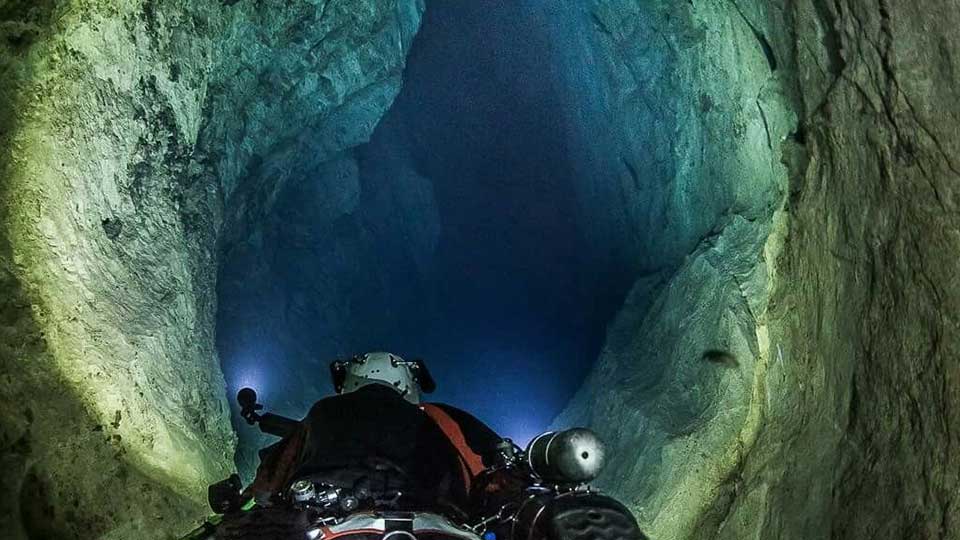
More information about Canyon Matka can be found on this website.
Kanjon Matka
Kanjon Matka - atraktivno turističko odredište u Skoplju
Kanjon Matka je kanjon rijeke Treske, desne pritoke Vardara, prostire se na oko 5.000 hektara i nalazi se 17 km jugozapadno od Skoplja. Prema morfogenetskim karakteristikama je kanjon-razbijač. Kraški oblici zaslužuju posebnu pozornost na ovom području. Riječ je o deset špilja duljine od 20 do 176 metara i dvije strmine dubine do 35 metara.

Kanjon Matka-reliktne i endemske biljke i životinje
Kanjon Matke je jedan od najvećih refugijskih centara tijekom glacijalnog razdoblja, koji je danas pridonio prisutnosti mnogih reliktnih i endemičnih biljaka i životinja. Od ukupno 1000 vrsta biljaka, 20% su endemi ili relikti. Među tercijarnim relikvijama značajnije su ljubičasta ljubičica (Viola kosaninii) i natalijeva ramonda (Ramonda nathaliae).

Na lokalitetu Matka otkrivene su dvije nove vrste pravih pauka i pet lažnih škorpiona. U kanjonu Matke registrirano je 119 vrsta dnevnih i 140 vrsta noćnih leptira. Važno je napomenuti da se u kanjonu Matke nalazi 77 vrsta balkanskih endemskih leptira, dok je još 18 vrsta novih za znanost.
Unutar kanjona nalazi se speleološki park "Jovica Grozdanovski", nazvan po tragično poginulom penjaču. Park se sastoji od tri špilje (Vrelo, Ubava i Krstana), kao i podvodna špilja (Podrevlo).

Jezero Matka
Matka - komad netaknute prirode
U sjeverozapadnom dijelu Makedonije, u blizini Skoplja, na rijeci Treskoj nalazi se jezero Matka. Jezero Matka je najstarije umjetno jezero u Makedoniji, čija je akumulacija izgrađena 1938. godine. Akumulacijsko jezero Matka prostire se 7 kilometara nizvodno uz rijeku Tresku, veličanstveno sa svojom metalik sivo-zelenom bojom. Strme sive sedimentne stijene, omiljena ruta i vječni izazov planinara - pustolova, uzdižu se visoko iznad jezera. A svojim obalama oštro seku tajanstvenu vodenu površinu jezera.

Prekrasan komad netaknute prirode, bogat rijetkim životinjskim vrstama i endemskim biljkama samo 15 km od glavnog grada. Nešto sa čime se rijetko može pohvaliti bilo koja zemlja na svijetu. Matka je dom velike riznice prirodnih rijetkosti, bogatih hrastova i bukovih šuma, prekrasnih ružičastih cvjetova Natalie's Ramonda, bijelih orlova, jedinstvenim leptirima i speleološkim objektima. Ova lokacija obiluje brojnim kulturno-povijesnim spomenicima, uglavnom samostanima, zbog kojih je s pravom nazivaju malom Svetom Gorom.
Temperatura vode u jezeru Matka iznosi 7 do 9 stupnjeva Celzija, a temperatura zraka ljeti je oko 9 stupnjeva niža od one u gradu. Od brane Matke 1 do Matke 2 ima devet kilometara, a do Kozjaka ukupno 25. Dobilo se pregradnjom rijeke Treske branom (Sveti Andreja) i stvaranjem umjetne akumulacije u kanjonu Matke. Iz jezera se voda koristi za dobijanje električne energije, ali i za navodnjavanje sela u okolici. Jezero je opskrbljeno i često se koristi za sportski ribolov. U ovom jezeru nalazi se podvodna pećina Vrelo, jedna od najdubljih podvodnih špilja u Europi, dubine preko 203 m.
Špilja Vrelo
Matka je prirodni kanjon koji je kao geografski reljef zaista poseban, a speleološki park je jedan od najfascinantnijih na svijetu. Od desetak špila u speleološkom parku, Vrelo je jedina koja trenutno djeluje kao turistička atrakcija. Neposredna blizina jezera Matka čini ga najpogodnijim za turističku eksploataciju. Dva jezera u unutrašnjosti i nekoliko lijepih i velikih špiljskih galerija čine ga zanimljivim za posjetitelje. Do nje se stiže za dvadeset minuta, s jednom od četiri čamca stacionirana ispred restorana Kanjon Matka. U samoj špilji nalaze se brojni špiljski ukrasi, među kojima dominira ogromni stalagmit u obliku stošca, koji se nakupio za 2.700 godina. Zvukovi koji se stalno čuju u unutrašnjosti pećine potječu od stanovnika - šišmiša.

Još traju istraživanja špilje pod Vrelom, koja je ispunjena vodom, i jedina je takva u Makedoniji, a prema dosadašnjim istraživanjima očekuje se da će ona biti najveća u Europi. Ovdje možete vidjeti i vrelo za koju se pretpostavlja da dolazi iz Patiške Reke, udaljene samo 15 km. Osim špilje Vrelo, tu su i špilje Ubava i Krštalna.
Kulturno-povijesni spomenici
Osim što je zaštićena kao spomenik prirode, Matka obiluje brojnim kulturno-povijesnim spomenicima koji nju definiraju kao malu Svetu Goru. Sada postoji oko desetak samostana, među kojima je i Šiševski, posvećen Sveti Nikoli, izgrađen ili obnovljen 1345. godine, samostan "Sveti Ivana Zlatoustom "u selu Kozarevo, samostan" Sveta Majka "u blizini sela Glumovo, samostan" Sveti Andrej ", crkve" Sveti Trojstvo "," Sveti Petka "," Sveti Atanas "," Sveti Nikola "u Niru i" Sveta Nedela ". Ljubitelji kulturnih i povijesnih spomenika mogu dobiti organizirane aranžmane, uključujući posjet Markovom gradu, srednjovjekovnom naselju-tvrđavi iz 14. stoljeća. U tvrđavi se nalaze ostaci crkava "Sv.Nedela", "Sveti Georgi" i "Sveti Troica".

Tu je i lokalitet nazvan Markova noga, kojemu su povezane legende o Kralju Marka. Jedna od njih se odnosi na beljeg zida u samostanu "Sveti Andreje", nazvan Marova ruka. Prema legendu Kralj Marko s bratom Andrejom prolazili su tu te su stali da se odmore i osviježe. Andreja je ušao u kafanu koja se nalazila na mjestu sadašnjem restoranu, u kojoj su bili turski vojnici (asker). Turci su ubili Andreju, a Kralj Marko, nakon što ga je odmazdio, kao znak predupređenja ostavio je otisak svog dlana u zidu samostana.
Turistička ponuda
Najljepši pogled iz samostana "Sv.Nikola" proteže se do planinarskog doma i samostana "Sv.Andreja". Tamo možete stići pješice za oko 2 sata, a nakon spuštanja dolaze po vas s jednim od brodova. "Sveti Jovan Zlatoust" je sljedeće odredište, a imate pola sata hoda do ljekovitog izvora. Za Markov grad i crkvu "St.Nedela" stiže se za oko 80 minuta. Brojne staze pružaju izvanredna iskustva i izvrsna su rekreacija, a najveće zadovoljstvo su prekrasni pogledi koji oduzimaju dah. Brojne se staze isprepliću i nadopunjuju, tako da, kažu, nemoguće je izgubiti se.
Za ljubitelje ekstremnijih sportova Matka ima mogućnosti za sportsko penjanje i alpinizam. S obzirom da je Matka, između ostalog, srce planinarstva u Makedoniji, odavde počinje i alpinistička povijest. Alpinističke i sportsko-alpinističke staze uglavnom se nalaze na pet lokaliteta: Centrala, Otmarova karpa, Karpa doma, Matkino Trlo i Igli kod Matke. Među ostalim ponuđenim sadržajima je i Kajak centar gdje je 1975. godine održano Prvo svjetsko prvenstvo u kajaku na divljim vodama i Europsko prvenstvo u kajaku.

